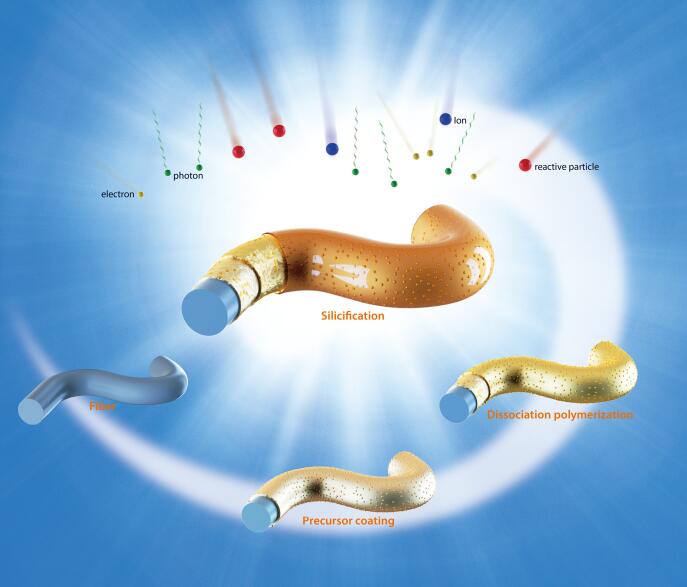INVITED REVIEW
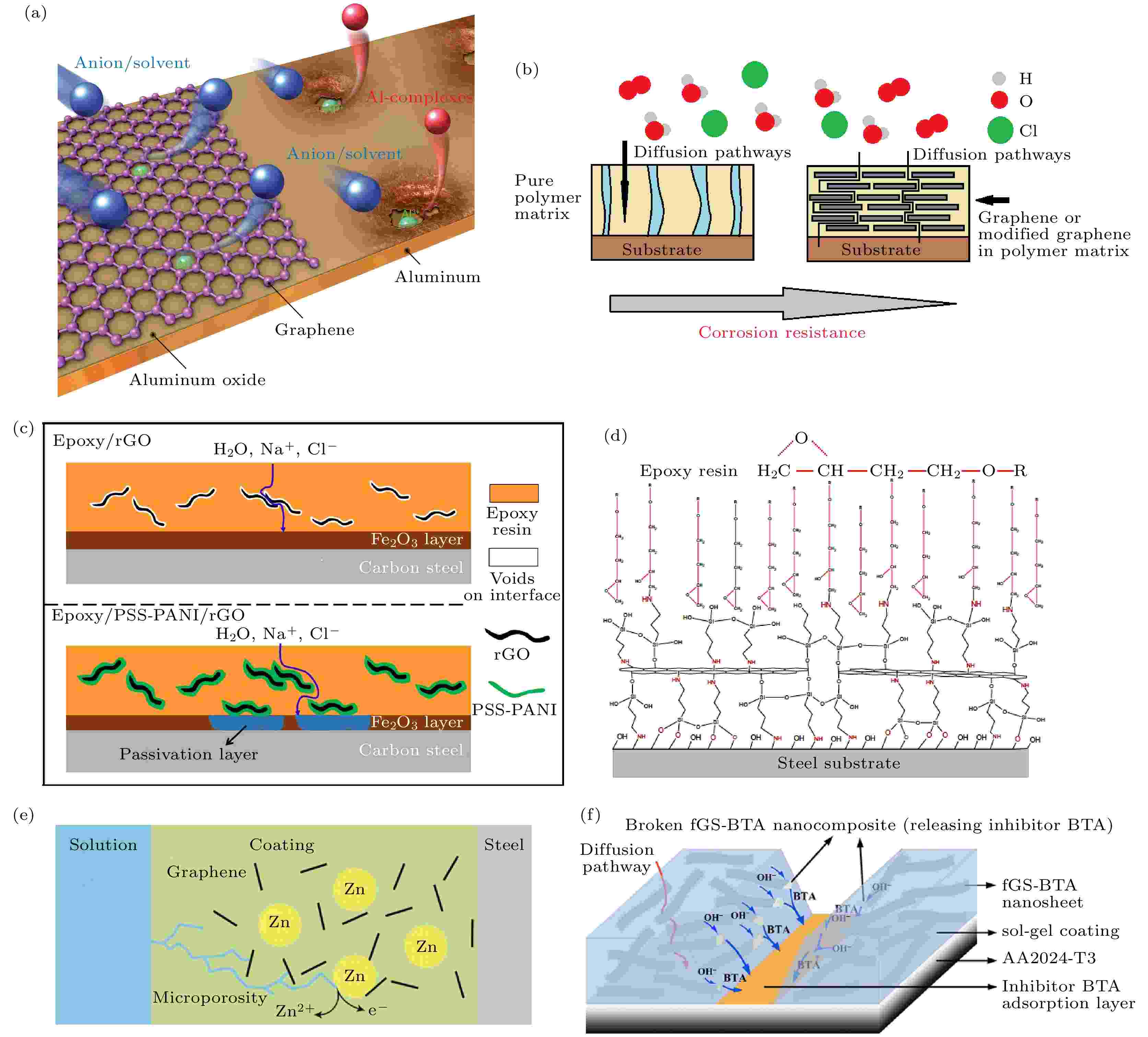
INVITED REVIEW
2021, 70 (9): 098102.
doi: 10.7498/aps.70.20210349
Abstract +
As an emerging material, graphene has become a research hotspot in the field of anti-corrosion because of its excellent chemical inertia and permeability resistance. In this paper, combined with the latest research results, the applications of graphene film and graphene powders in the field of anti-corrosion are discussed more comprehensively. First, the anti-corrosion mechanisms of graphene (mainly including barrier effect, shielding effect, corrosion inhibition synergy, enhancement of coating adhesion, cathodic protection, and self-healing effect) and its corresponding coating preparation methods (graphene film prepared by chemical vapor deposition method and composite coatings prepared with graphene powders) are introduced. Then, the influences of different factors such as defects, conductivity, oxidation degree, flake size, and content of graphene on the anti-corrosion performance are discussed. Finally, various methods are comprehensively compared with each other, and future development is prospected. This paper not only reviews the existing work, but also has a certain reference value for preparing graphene materials with better corrosion resistance in the future.
SPECIAL TOPIC—Several problems in plasma physics and material treatment
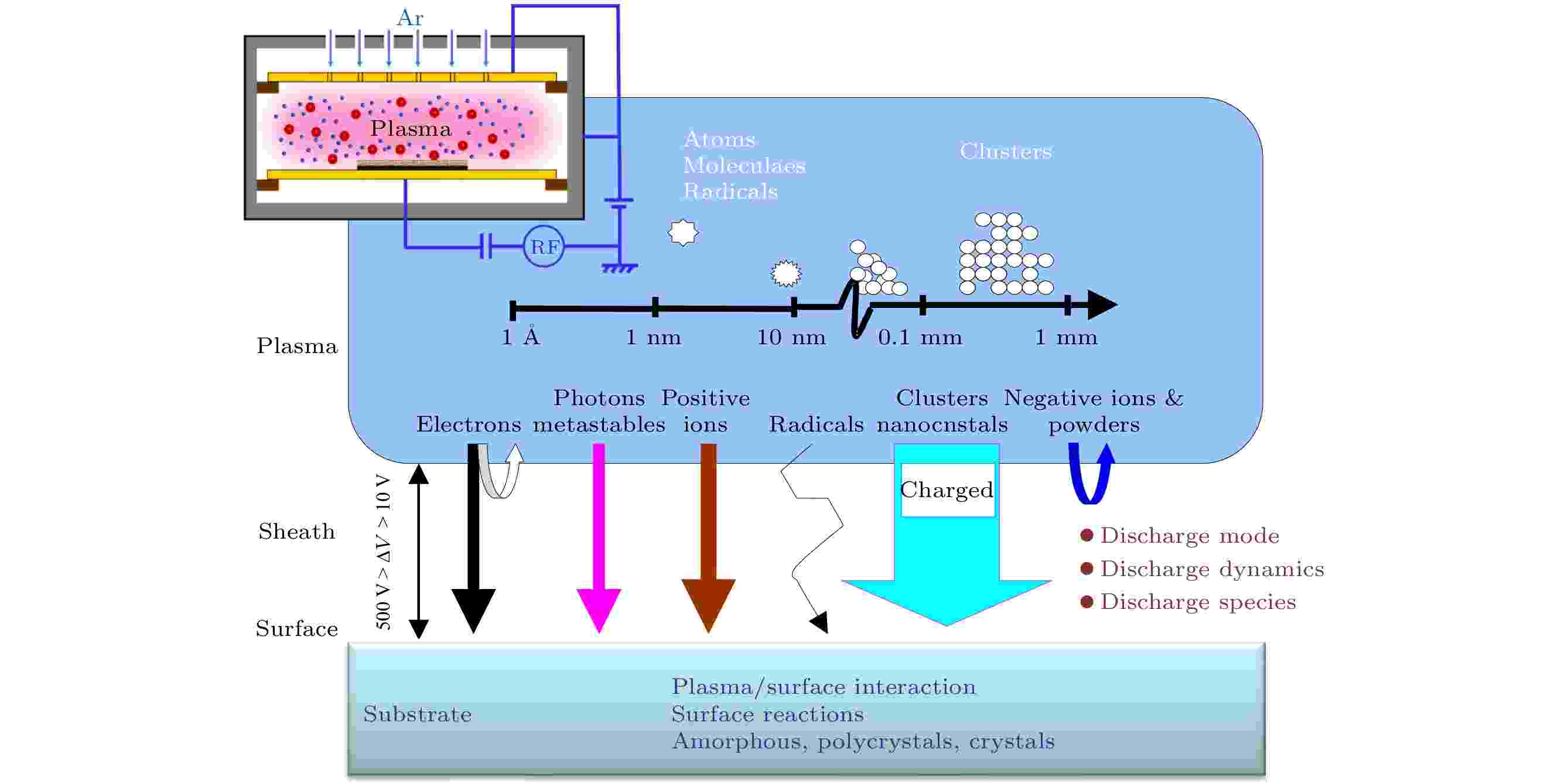
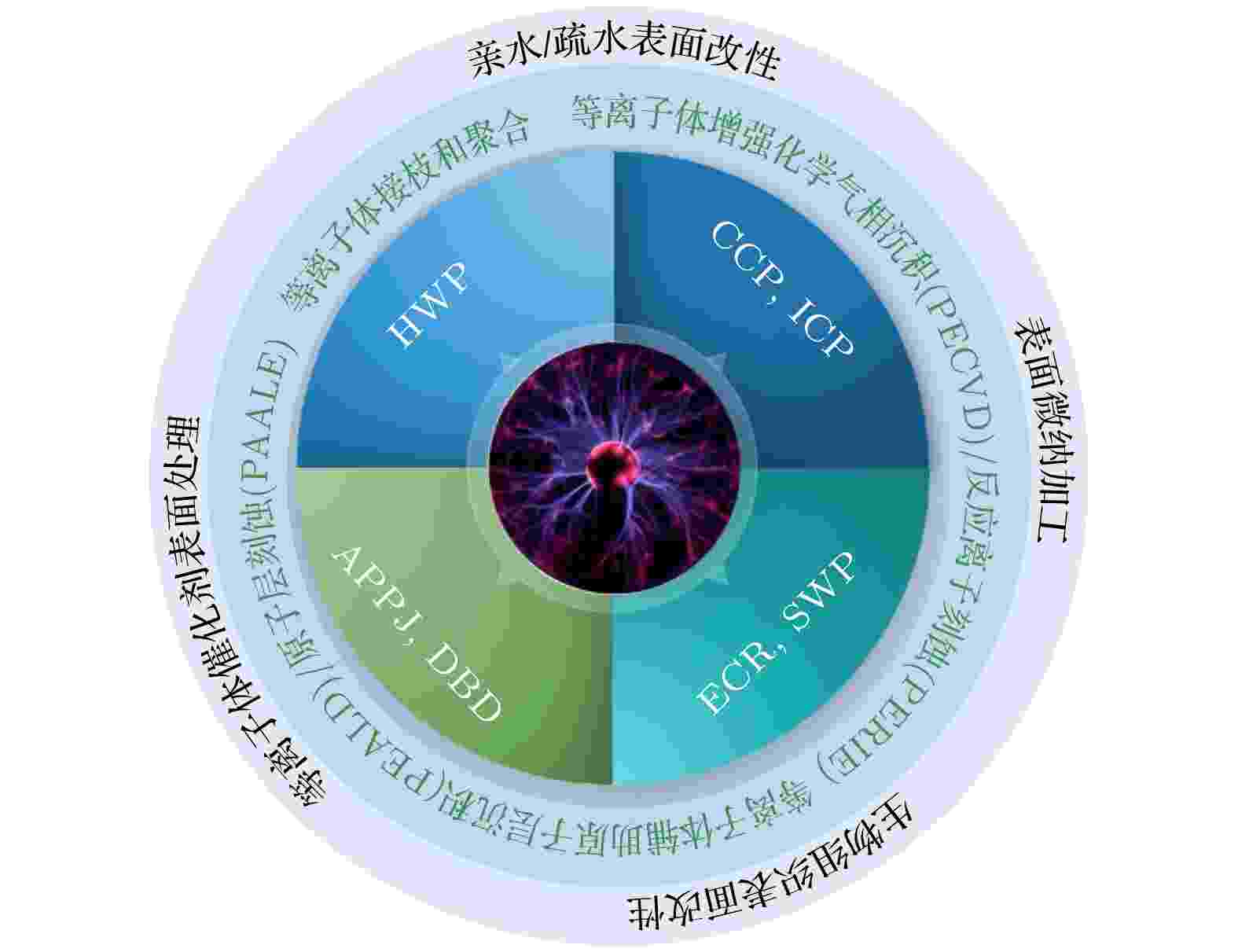
EDITOR'S SUGGESTION
2021, 70 (9): 095203.
doi: 10.7498/aps.70.20202233
Abstract +
Plasma technology plays an important role in preparing and processing materials nowadays. This review focuses on the applications of non-thermal plasma (NTP) in the surface treatment and functionalization of materials, including the plasma sources for generating plasmas, NTP techniques and specific application fields. The plasma sources include inductively coupled plasma, capacitively coupled plasma, electron cyclotron resonance plasma, surface wave plasma, helicon wave plasma, atmospheric pressure plasma jet, and dielectric barrier discharge plasma. The NTP techniques for material surface treatment and functionalization include plasma surface grafting and polymerization, plasma enhanced chemical vapor deposition, plasma assisted atomic layer deposition, plasma enhanced reactive ion etching, and plasma assisted atomic layer etching. Specific applications of plasma surface treatment and functionalization cover hydrophilic/hydrophobic surface modification, surface micro-nano processing, biological tissue surface treatment, and catalyst surfaces treatment. Finally, the application prospects and development trends of NTP technology for material surface treatment and functionalization are proposed.
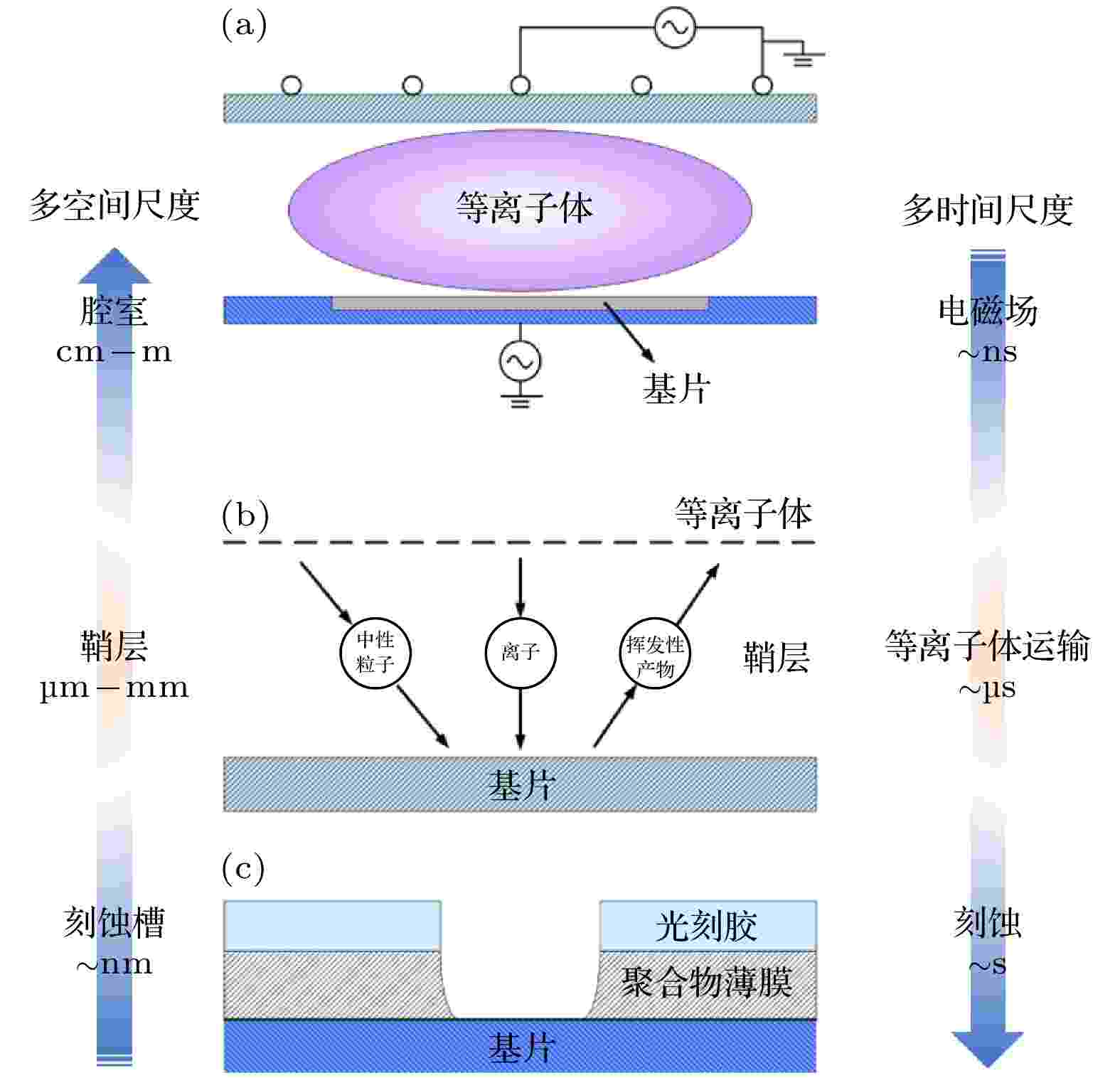
2021, 70 (9): 095206.
doi: 10.7498/aps.70.20202247
Abstract +
Inductively coupled plasmas have been widely used in the etch process due to the high plasma density, simple reactor geometry, etc. Since the plasma characteristics are difficult to understand only via experiments, the numerical study seems to be a valuable and effective tool, which could help us to gain an in-depth insight into the plasma properties and the underlying mechanisms. During the past few years, various models have been employed to investigate inductive discharges, such as global model, fluid model, fluid/Monte Carlo collision hybrid model, biased sheath model, particle-in-cell/Monte Carlo collision hybrid model, etc. Since the plasma parameters are volume averaged in the global model, which effectively reduces the computational burden, it is usually used to study the reactive gas discharges with a complex chemistry set. In order to obtain the spatial distribution, a two-dimensional or three-dimensional fluid model is necessary. However, in the fluid model, the electron energy distribution function is assumed to be Maxwellian, which is invalid under special discharge conditions. For instance, strong electric field and low pressure may result in non-Maxwellian distributions, such as bi-Maxwellian distribution, two-temperature distribution, etc. Therefore, a fluid/Monte Carlo collision hybrid model is adopted to take the electron kinetics into account. Besides, a separate biased sheath model is necessary to study the influence of the sheath on the plasma properties self-consistently. The particle-in-cell/Monte Carlo collision hybrid model is a fully kinetic method based on the first-principles, which could be used to investigate the non-local and non-thermal equilibrium phenomena. In conclusion, the numerical investigation of inductively coupled plasmas has a significant importance for plasma process optimization.
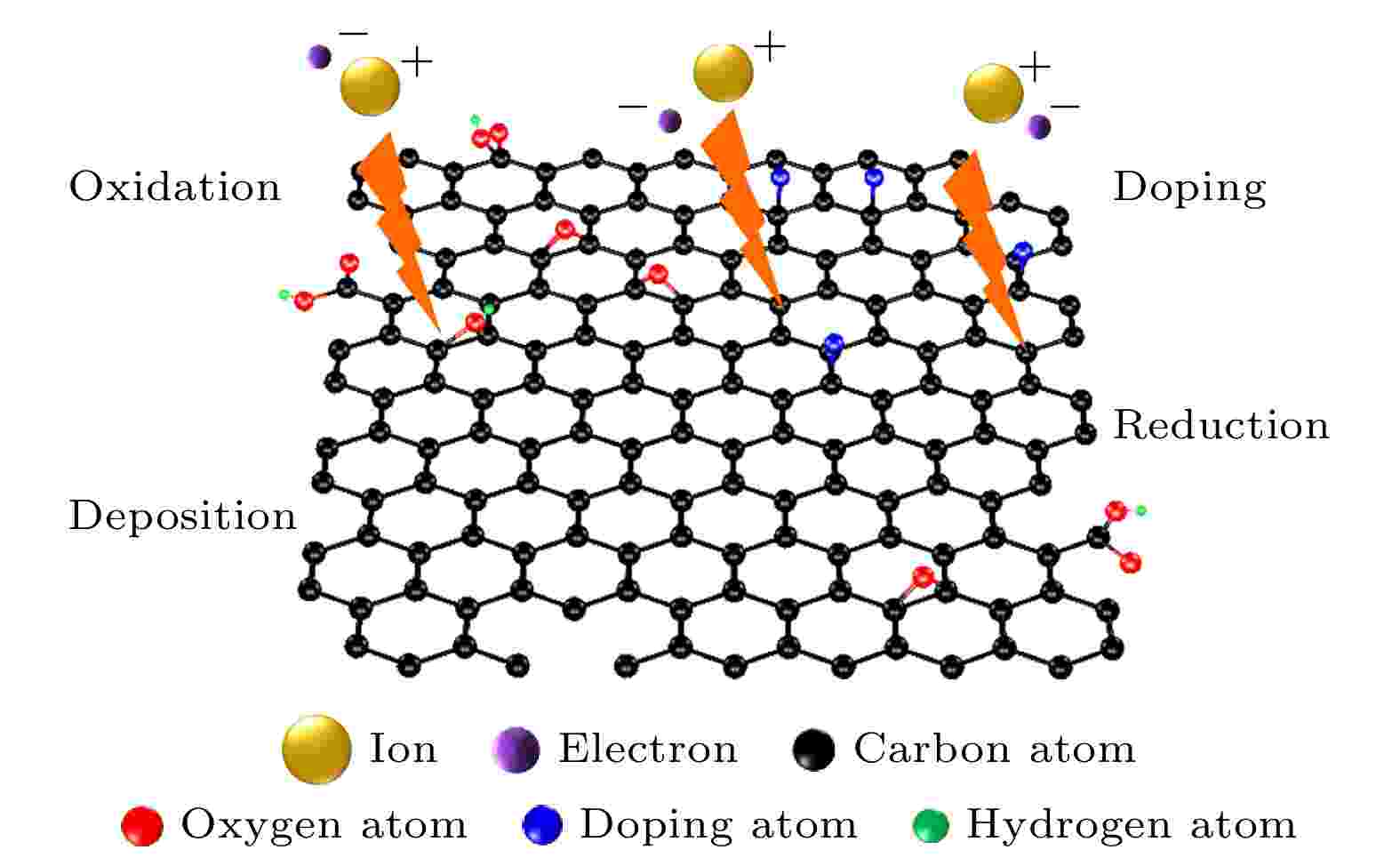
EDITOR'S SUGGESTION
2021, 70 (9): 095208.
doi: 10.7498/aps.70.20202078
Abstract +
Plasma contains highly reactive species, including electrons, ions, radicals, photons, etc., which are critical for catalyzing or directly participating in chemical reactions. Plasma is a highly efficient tool in chemical synthesis and material modification, since it can make the chemical reactions that are difficult or even impossible to occur under thermal equilibrium conditions take place and accelerate through its catalysis. The chemical reactivity of graphene under conventional conditions is low, which means that the reaction of graphene requires high temperature, high pressure and/or strong acid or alkali, thereby restricting the synthesis and modification of novel graphene-derived materials. Plasma-assisted graphene reaction can trigger a series of chemical reactions, such as reduction, oxidation, defect repair, doping, grafting, epitaxial growth and cross-linking of graphene, under ambient temperature and pressure without any corrosive conditions. It provides great potentials for the functional modification of graphene and the synthesis of graphene composites, which deserve further exploration. Over the past decade, a number of studies of graphene synthesis and modification by using plasma with distinctive characteristics have been reported. However, most of reports focused on the presentation of technical routes and corresponding results, and the research on chemical reaction kinetics is still far from being fully addressed. In this review, we make a comprehensive discussion about these reports by mainly summarizing and discussing some of the representative results, in order to promote further research in the relevant fields.
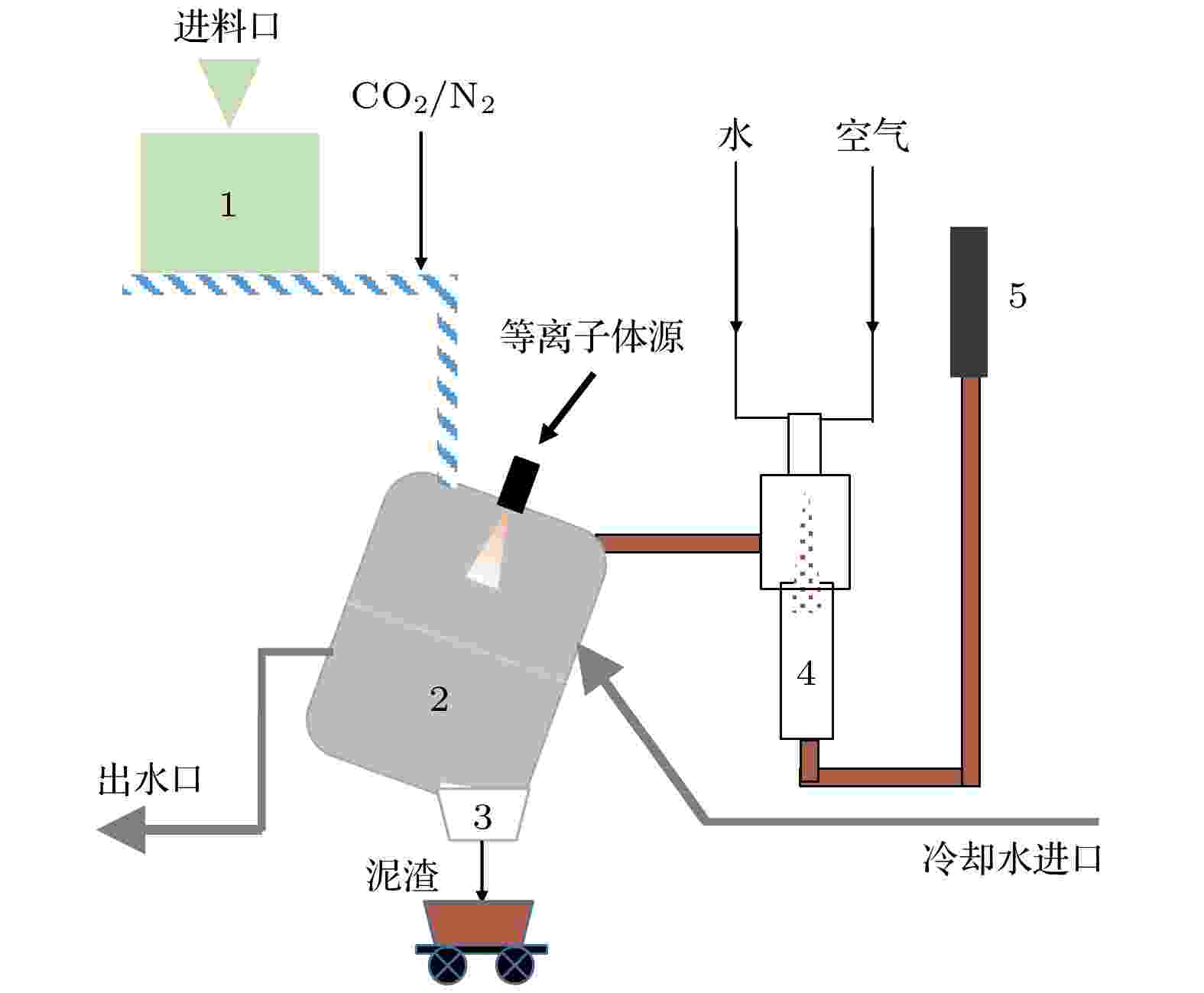
2021, 70 (9): 095210.
doi: 10.7498/aps.70.20201676
Abstract +
The rapid development of social economy leads the output of solid waste to increase rapidly. The traditional treatment methods, such as landfilling, incineration and composting, are not only inefficient, but also have many limitations, such as secondary pollution and waste of resources. Therefore, it is urgent to explore new solid waste treatment technology. Due to its high efficiency, environmental protection and high energy conversion, the plasma gasification technology has been applied to the harmless treatment of solid waste. This article introduces the background and significance of plasma gasification technology in solid waste treatment, and summarizes the application of plasma gasification technology to different solid waste treatments, the technical level and research progress of plasma gasification of solid waste in the world are described in detail, and the existing problems in the current application of plasma gasification of solid waste are emphatically analyzed. It is pointed out that plasma gasification technology is an effective way to treat solid waste.

2021, 70 (9): 095214.
doi: 10.7498/aps.70.20210473
Abstract +
Capacitively coupled plasma (CCP) has gain wide attention due to its important applications in industry. The researches of CCP mainly focus on the discharge characteristics and plasma parameters under different discharge conditions to obtain a good understanding of the discharge, find good methods of controlling the charged particle properties, and improve the process performance and efficiency. The controlling of plasma parameters is based on the following three aspects: gas, chamber, and power source. Changing these discharge conditions can directly influence the sheath dynamics and the charged particle heating process, which can further influence the electron and ion distribution functions, the plasma uniformity, and the production of neutral particles, etc. Based on a review of the recent years’ researches of CCP, the electron heating dynamics and several common methods of controlling the plasma parameters, i.e. voltage waveform tailoring, realistic secondary electron emission, and magnetized capacitively coupled plasma are introduced and discussed in detail in this work.

2021, 70 (9): 098104.
doi: 10.7498/aps.70.20202245
Abstract +
With the shrinkage of chip feature sizes, porous materials are widely used in microelectronics. However, they are facing severe challenges in plasma etching, as the reactive radicals can diffuse into the interior of material and damage the material, which is called plasma induced damage. In this paper, we review two kinds of etching processes based on low chuck temperature, i.e. cryogenic etching. By lowering the chuck temperature, either the etching by-products or the precursor gas can condense in the porous material, and thus preventing the radicals from diffusing and protect the material from being damaged by plasma. The technology of cryogenic filling inside the porous material is simple but effective, which allows it to have a good application prospect.

EDITOR'S SUGGESTION
2021, 70 (9): 099401.
doi: 10.7498/aps.70.20210077
Abstract +
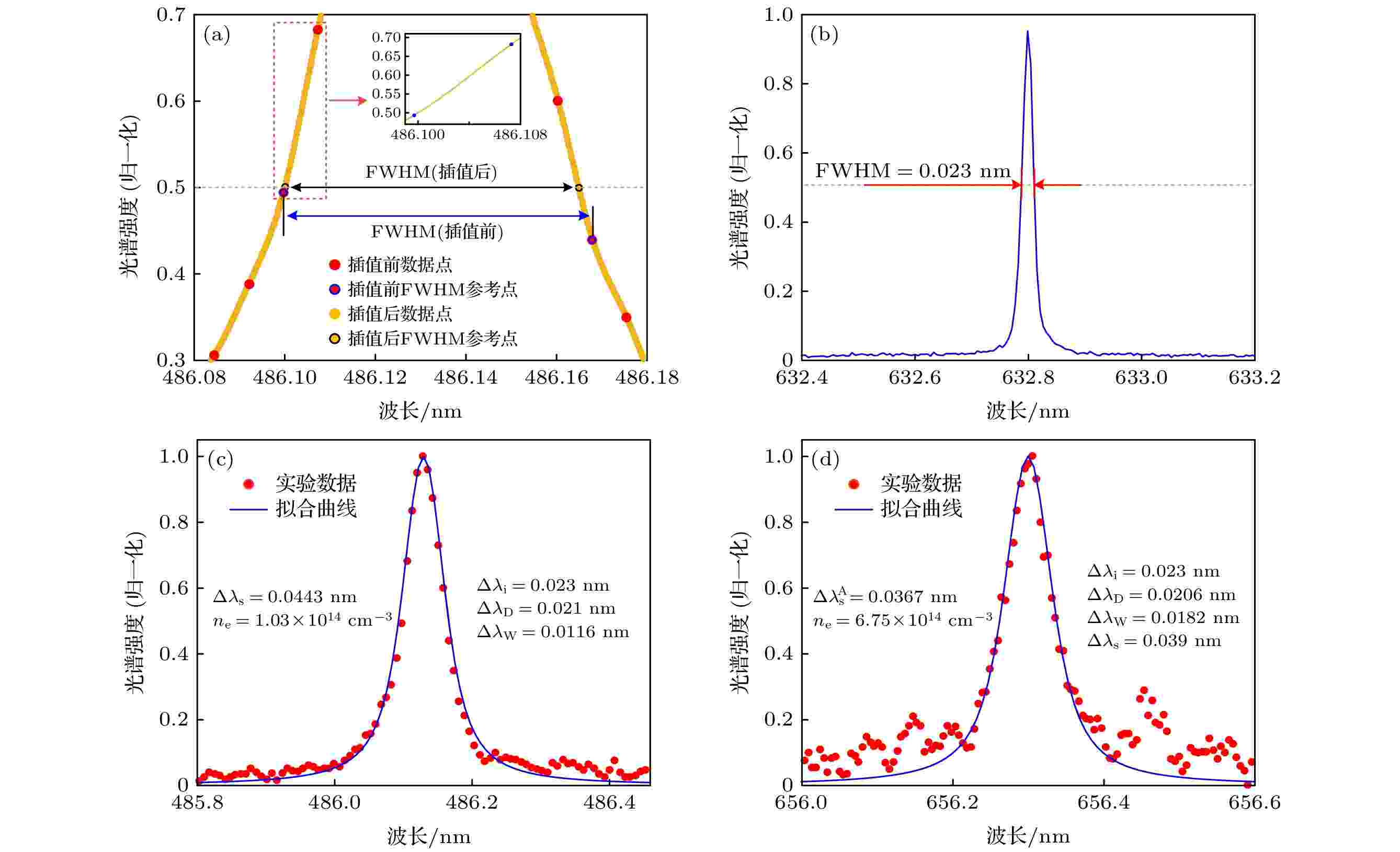
2021, 70 (9): 095201.
doi: 10.7498/aps.70.20201790
Abstract +
Based on the Stark broadening method and the imaging method, the electron densities of the plasma generated at different pulse frequencies, gap distances and inner diameters of the electrodes are diagnosed. The experimental results indicate that reducing the pulse frequency, shortening the gap distance between the electrodes, and using thinner diameter electrode are all in favor of enhancing the electron density. With the help of the global model, we perform the numerical simulation to explore the factors that influence the variation of the electron density. According to the simulations results, we find that the reduced discharge volume results in the increase of electron density with the increase of pulse frequency. When the gap distance between the electrodes is reduced, although the increased absorbed power and the reduced discharge volume both have an effect on the electron density, the reduced discharge volume plays a decisive role in these two factors. Moreover, using a thinner inner diameter electrode can also reduce the discharge volume, which is of benefit to obtaining the plasma with high electron density.
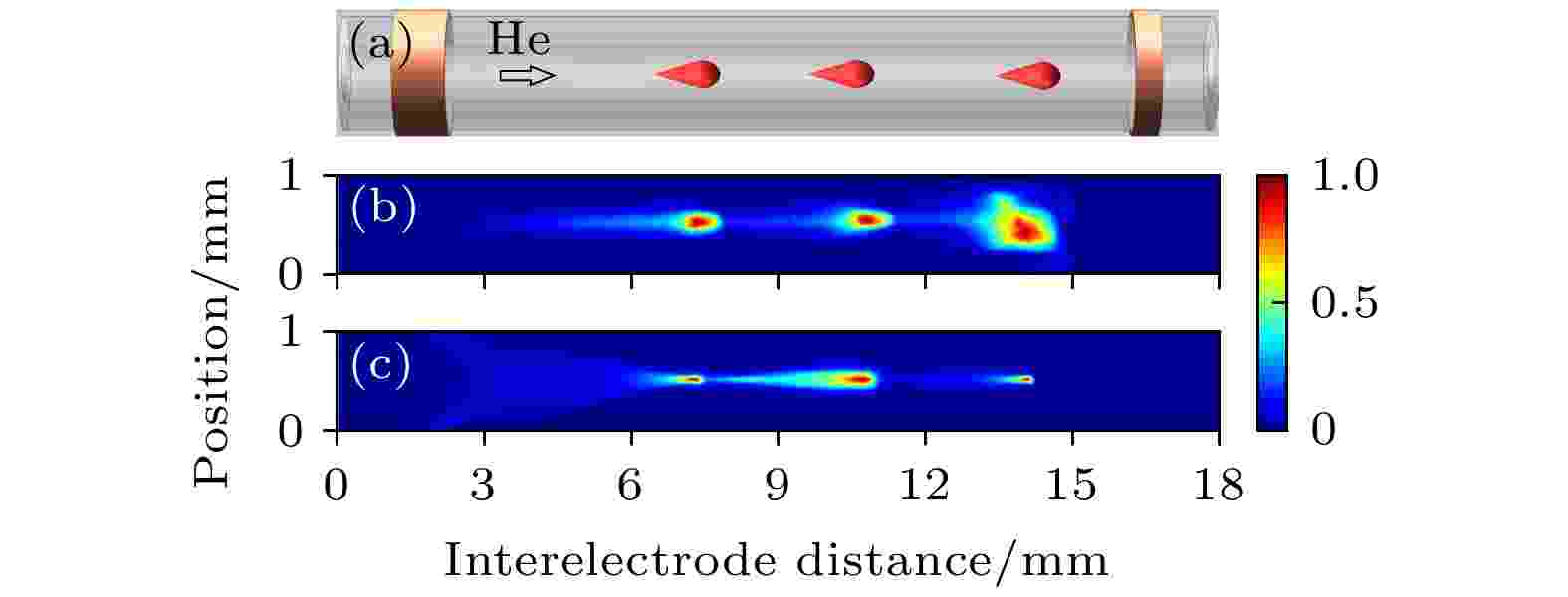
2021, 70 (9): 095202.
doi: 10.7498/aps.70.20202246
Abstract +
Atmospheric pressure plasma plume generated by pulsed discharge is studied by experimental diagnostics and numerical simulations. It is found that the plasma plume is generated in the rising phase of pulse voltage, in which a plasma bullet propagates toward the ground electrode at a speed on the order of 104 m/s. It is also found that the electric field in the vicinity of the plasma bullet reaches 106 V/m, indicating that the formation of plasma bullet can be attributed to the localized enhanced electric field, which will be enhanced near to the grounded electrode. The spatiotemporal evolution of electron density in the discharge reveals that the residual electron density remains after the plasma bullet has passed through, which explains the tailing phenomenon of plasma bullet. The enhanced electron generation rate at the head of plasma bullet corresponds to the localized enhanced electric field, which explains the generation mechanism of plasma bullet. This study of the characteristics and mechanism of plasma bullet provides a theoretical basis for developing the atmospheric plasma plume generated by pulsed discharge.
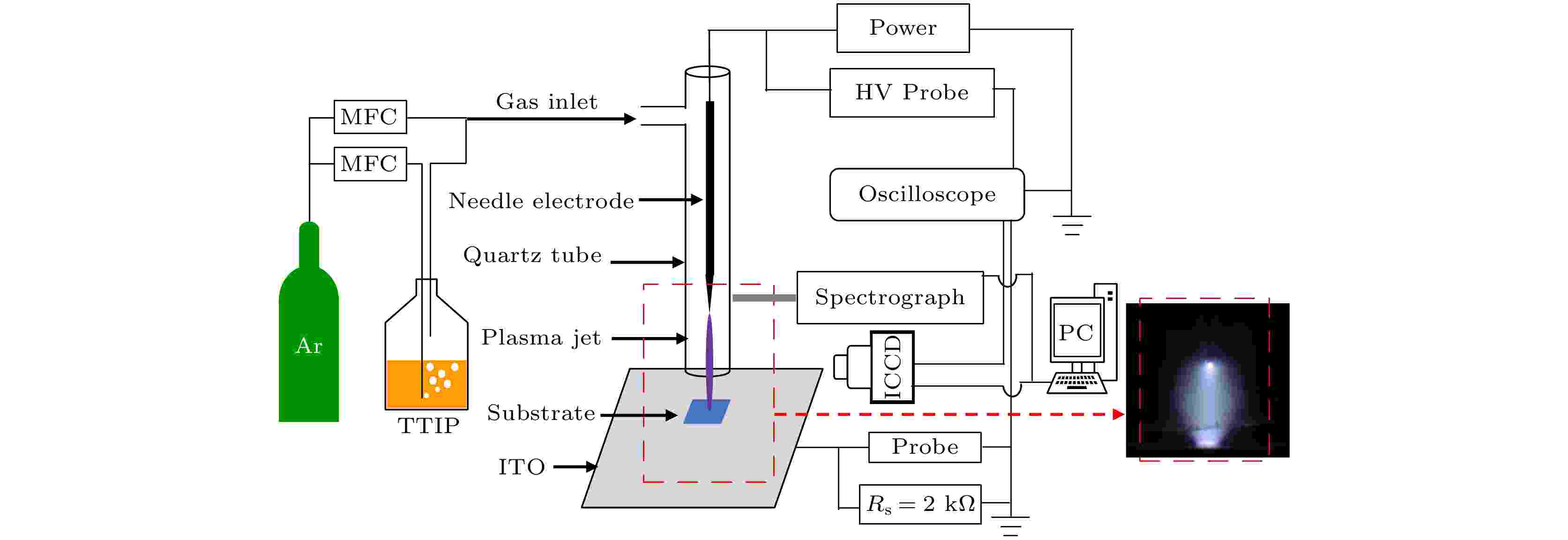
EDITOR'S SUGGESTION
2021, 70 (9): 095205.
doi: 10.7498/aps.70.20202181
Abstract +
Atmospheric pressure plasma jet has received increasing attention due to its wide potential applications such as in material processing and surface modification. This paper presents the characteristics of titanium oxide (TiO2) thin films deposited by using atmospheric pressure corona plasma jet based on a needle-plate configuration. The influences of corona polarity and operating parameters on the properties of TiO2 films are investigated. The characteristics of positive and negative corona discharge, the developing process and the emission spectrum of the plasma jet are tested, and the TiO2 films prepared under different conditions are measured and analyzed. The results show that the TiO2 film prepared by negative corona plasma has a more uniform surface, and the Ti content in TiO2 film is higher than that by the positive corona plasma. The adhesion force is higher than 4.7 N/cm and the surface resistance of the film is less than 1010 Ω. The deposition of the TiO2 film is closely related to the nucleation mechanism of the precursor in the plasma jet and/or the interface between jet and substrate. These results will provide useful reference for preparing uniform and functional oxide film materials by atmospheric pressure plasma jet.
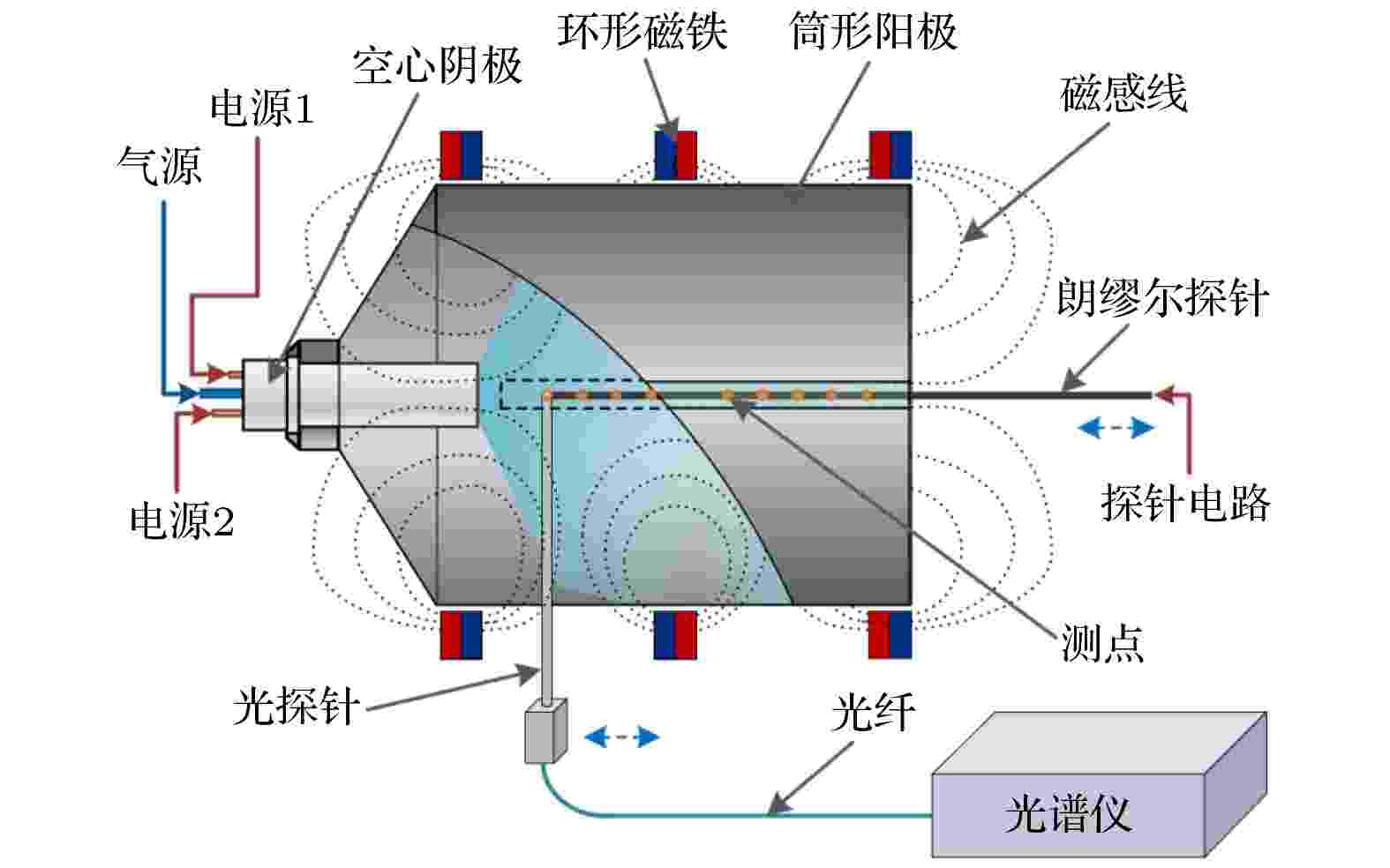
2021, 70 (9): 095211.
doi: 10.7498/aps.70.20202248
Abstract +
Optical emission spectroscopy (OES) has been widely applied to plasma etching, material processing, development of plasma equipment and technology, as well as plasma propulsion. The collisional-radiative model used in OES is affected by the deviation of fundamental data such as collision cross sections, thus leading to the error in diagnostic results. In this work, a novel method is developed based on feedforward neural network for OES. By comparing the error characteristics of the new method with those of the traditional least-square diagnostic method, it is found that the neural network diagnosis method can reduce the transmission of basic data deviation to the diagnosis results by identifying the characteristics of the spectral vector. This is confirmed by the experimental results. Finally, the mechanism of the neural network algorithm against fundamental data deviation is analyzed. This method also has a good application prospect in plasma parameter online monitoring, imaging monitoring and mass data processing.
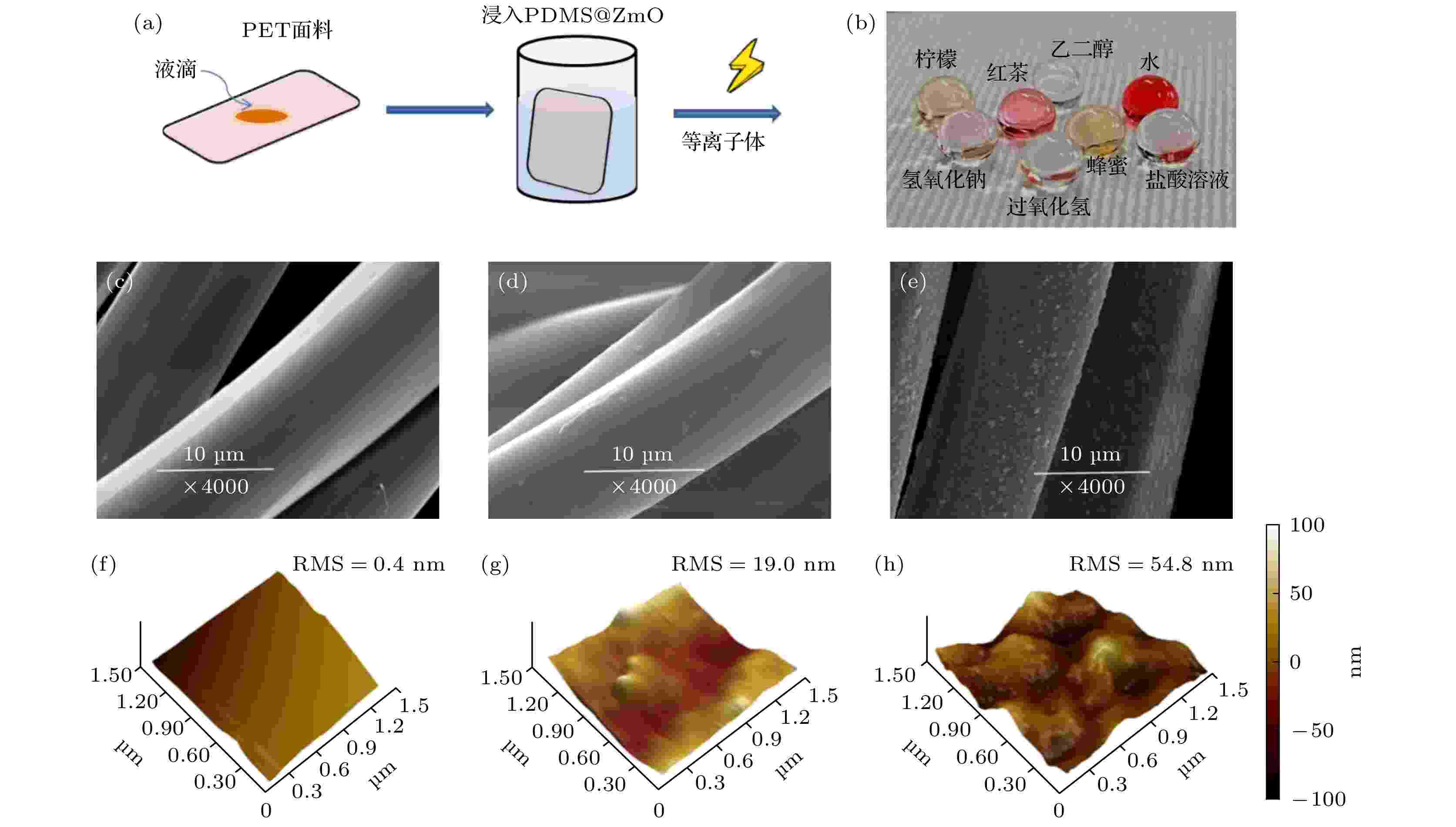
COVER ARTICLE
2021, 70 (9): 095212.
doi: 10.7498/aps.70.20210585
Abstract +
The ultra-durable, self-healing superhydrophobic polyester fabric based on ZnO@PDMS nanoparticle composite coating (PET-g-PDMS@ZnO fiber) is prepared by low-temperature plasma polymerization. The influences of the preparation process on the superhydrophobicity, self-healing property, durability and stability of the coating are studied. The results show that the water contact angle on the surface of PET-g-PDMS@ZnO fabric can reach 162.7°, and the sliding angle is 7.5°. After 300 washing cycles and 1300 rubbing cycles, the superhydrophobic property is still maintained. Both plasma method and heating method are used to repair the worn coating, and it is found that the repair effect of plasma is obvious, while the heating repair is effective only in the case of small loads. Moreover, scanning electron microscope, nanoindentation and X-ray photoelectron spectroscopy measurement are used to explore the self-healing mechanism. This research provides the theoretical and technical support for the development and application of plasma technology in the preparation of superhydrophobic fabrics.
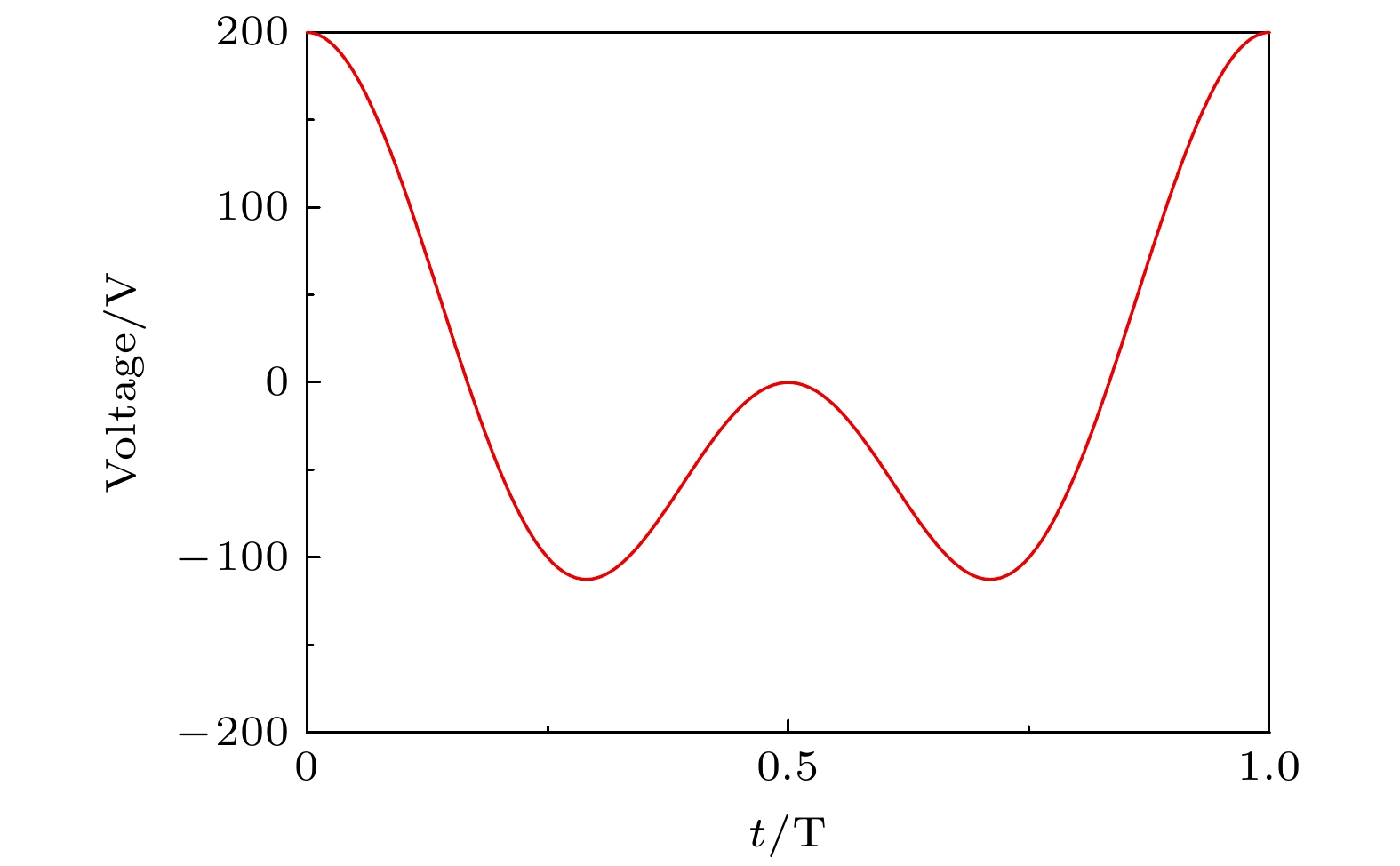
2021, 70 (9): 095213.
doi: 10.7498/aps.70.20210546
Abstract +
The capacitive CF4/Ar discharges driven by a dual frequency source based on the electrical asymmetry effect (EAE) are studied by using a one-dimensional fluid coupled with Monte-Carlo (MC) model and a two-dimensional trench model. The effects, induced by varying the relative gap distance, on self-bias voltage, electronegativity, ion flux, neutral flux and other plasma characteristics are systematically discussed. In this asymmetric discharge, as the gap distance increases, the absolute value of the self-bias voltage and electronegativity decrease. Meanwhile, the plasma density and absorption power increase accordingly because the effective discharge area expands but the boundary loss is still limited. In addition, both $ \mathrm{\alpha } $ mode and drift-ambipolar (DA) mode can play their important roles in the discharges with different gap distances, though DA mode is weakened in large gap discharge. Owing to the fact that the self-bias is larger and electronegativity is stronger for the case of smaller gap distance, the sheath expansion electric field at the powered electrode and the bulk electric field heat the electrons, leading the ionization rate to greatly increase near the collapse of the sheath at the grounded electrode. Besides, at the larger gap distance, the maximum value of the ionization rate decreases due to the reduction of electrons with relatively high-energy, and the ionization rate near the grounded electrode is reduced evidently. Moreover, with the increase of the gap distance, the maximum ion energy decreases and the ion energy distribution width becomes smaller due to the reduction of the self-bias voltage. Meanwhile, the etching rate increases a lot since the neutral flux increases significantly near the powered electrode. However, as the gap distance increases to 5 cm, the etching rate stops increasing and the trench width at the bottom becomes narrow because the neutral flux increases greatly compared with ion flux, forming a thick layer of polymer. So, besides separately controlling the ion energy and flux, optimizing the synergistic effect of ion flux and neutral group flux to adjust the etching rate and improve the etching morphology is also an interesting topic in the asymmetric CF4/Ar discharges.

2021, 70 (9): 097201.
doi: 10.7498/aps.70.20201809
Abstract +
A variety of carbon-based thin films are prepared by self-developed helicon wave plasma chemical vapor deposition (HMHX, HWP-CVD) through changing the parameters of plasma discharge. The Ar/CH4 plasma discharge is diagnosed in situ by Langmuir probe, emission spectroscopy and mass spectrometry. The carbon thin films are characterized by scanning electron microscopy (SEM) and Raman spectroscopy (Raman). The results show that under the given parameters, the plasma discharge modes are all helicon wave discharge modes. Under a given CH4 flow rate, the energy distribution in the plasma is enough to dissociate the methane molecules and form carbon free radicals. The preparation of different carbon-based films is realized by adjusting the CH4 fluence. The research result shows that when the plasma is rich in CH and H radicals, it is suitable for growing diamond-like carbon films. When the plasma is rich in C2 radicals and less H, it is favorable for growing vertical graphene nanosheets. According to the results of plasma diagnosis and material characterization, the decomposition mechanism of methane molecules under the action of Ar helicon wave plasma (HWP) is proposed, and the growth model of carbon-based materials is established, the feasibility of Ar/CH4-HWP in the preparation of carbon-based nanomaterials is verified, which provides a reference for preparing the carbon-based materials by HWP-CVD technology.
REVIEW

EDITOR'S SUGGESTION
2021, 70 (9): 098103.
doi: 10.7498/aps.70.20201813
Abstract +
In recent years, α-MoO3 has received extensive attention in the research of memristor devices. The variation of valence of molybdenum will lead the resistivity to change, and the unique layer structure is beneficial to the implantation of donor ion into free space to adjust the conductance, so that it has a great influence on the study of synaptic transistors. This paper mainly summarize the properties of α-MoO3, the method and characteristics of large-scale two-dimensional α-MoO3 and analyze the recent progress of in-memory computing based on α-MoO3. Primarily, this paper introduces crystal structures, band structure and defect state of α-MoO3. The synthesis methods of large-area α-MoO3 are compared with each other, including the one-step method to directly obtain α-MoO3 nanosheets, and the combined post-annealing process of magnetron sputtering or atomic layer deposition to prepare the thin α-MoO3 films. In the one-step synthesis method we conclude that the chamber pressure influences the ratio of MoO3 to MoO3–x, and the growth temperature affects the ratio of α-MoO3 to β-MoO3. That is to say, the phase composition of molybdenum trioxide, the concentration of precursors has an important influence on the film size. The advantages of α-MoO3 synthesis by different methods in memory computing applications are discussed in detail. And then, this paper summarizes the device performance of α-MoO3 in memristor and the application progress of α-MoO3-based neuromorphic devices, and analyzes the performance of α-MoO3-based resistive random access memory such as switching ratio, endurance, and stability in detail. The synaptic functions of different structural device units are extensively studied, and various typical synapse functions are realized such as short-term plasticity, long-term plasticity, paired pulse facilitation, etc. It shows the excellent characteristics of low energy consumption in the simulation of synaptic plasticity. The use of short-term memory and long-term memory modes of the device can realize the functions of image memory and preprocessing. Through the memristor array combined with the back-propagation network, the high-precision handwriting recognition can be realized. Finally, combining the recent research progress of α-MoO3, its opportunities and challenges in the field of memory computing are prospected.

2021, 70 (9): 098402.
doi: 10.7498/aps.70.20201762
Abstract +
The low-cost, high-efficiency and easy fabrication of perovskite solar cells make them an ideal candidate for replacing industrialized silicon solar cells, and thus reforming the current energy supply structure. However, the industrialization of perovskite solar cells is now restricted due to its poor stability. In this article, the intrinsic ion migration behavior in the perovskite film under light irradiation is introduced, which is mainly responsible for hysteresis, fluorescence quenching/enhancement and the failure of solar cell. In addition, the typical ultraviolet light instability of TiO2/perovskite interface, and the light instability of hole transport layer and metal electrodes are also discussed subsequently. As a light-dependent device, improving its light radiation stability is essential for making it suitable to various environmental applications.
GENERAL

2021, 70 (9): 090501.
doi: 10.7498/aps.70.20201254
Abstract +
In this paper, the effects of a Gaussian white noise excitation on the one-dimensional Frenkel-Kontorova (FK) model are studied by the stochastic Runge-Kutta method under two different types of substrate cases, i.e. incommensurate case and commensurate case. The noise excitation is considered through the inclusion of a stochastic force via a Langevin molecular dynamics approach, and we uncover the mechanism of nano-friction phenomenon in the FK model driven by the stochastic force. The relationship between the noise intensity and the nano-friction phenomenon, such as hysteresis, maximum static friction force, and the super-lubricity, is investigated by using the stochastic Runge-Kutta algorithm. It is shown that with the increase of noise intensity, the area of the hysteresis becomes smaller and the maximum static friction force tends to decrease, which can promote the generation of super-lubricity. Similar results are obtained from the two cases, in which the ratios of the atomic distance to the period of the substrate potential field are incommensurate and commensurate, respectively. In particular, a suitable noise density gives rise to super-lubricity where the maximum static friction force vanishes. Hence, the noise excitation in this sense is beneficial to the decrease of the hysteresis and the maximum static friction force. Meanwhile, with the appropriate external driving force, the introduction of a noise excitation can accelerate the motion of the system, making the atoms escape from the substrate potential well more easily. But when the chain mobility reaches a saturation state (B = 1), it is no longer affected by the stochastic excitation. Furthermore, the difference between the two circumstances lies in the fact that for the commensurate interface, the influence of the noise is much stronger and more beneficial to triggering the motion of the FK model than for the incommensurate interface since the atoms in the former case are coupled and entrapped more strongly by the substrate potential.
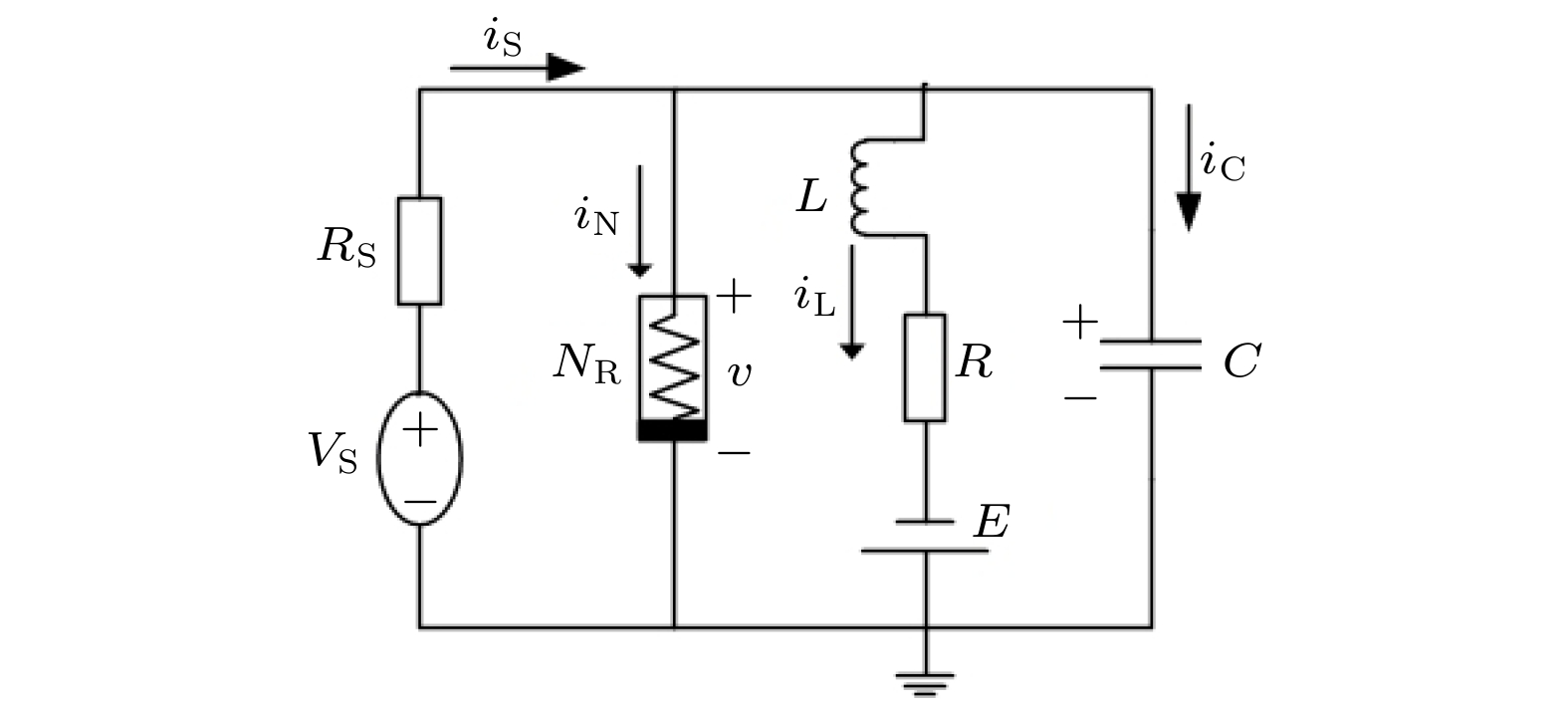
2021, 70 (9): 090502.
doi: 10.7498/aps.70.20201953
Abstract +
The photoreceptors can receive all kinds of visible light which is translated to the bioelectrical signal for the visual cortex. The function would be simulated by the photoelectric effect. This paper studies the dynamic characteristics of FitzHugh-Nagumo neurons coupled with a phototube. In the parameter space of phototube, the synchronization region of the coupled system in which the neuron mode is in chaos and burst, is discussed in detail; the data show that the forced resonance is prominent in the complete synchronization of the system when the coupling strength is low, while the phase synchronization is observed in numerical experiment when the coupling strength is strong. The active operation of the phototube, as well the inverse cutoff voltage can modulate the synchronization of the system. Our work can be used to understand the mechanism of the retinal diseases, such as macular degeneration.
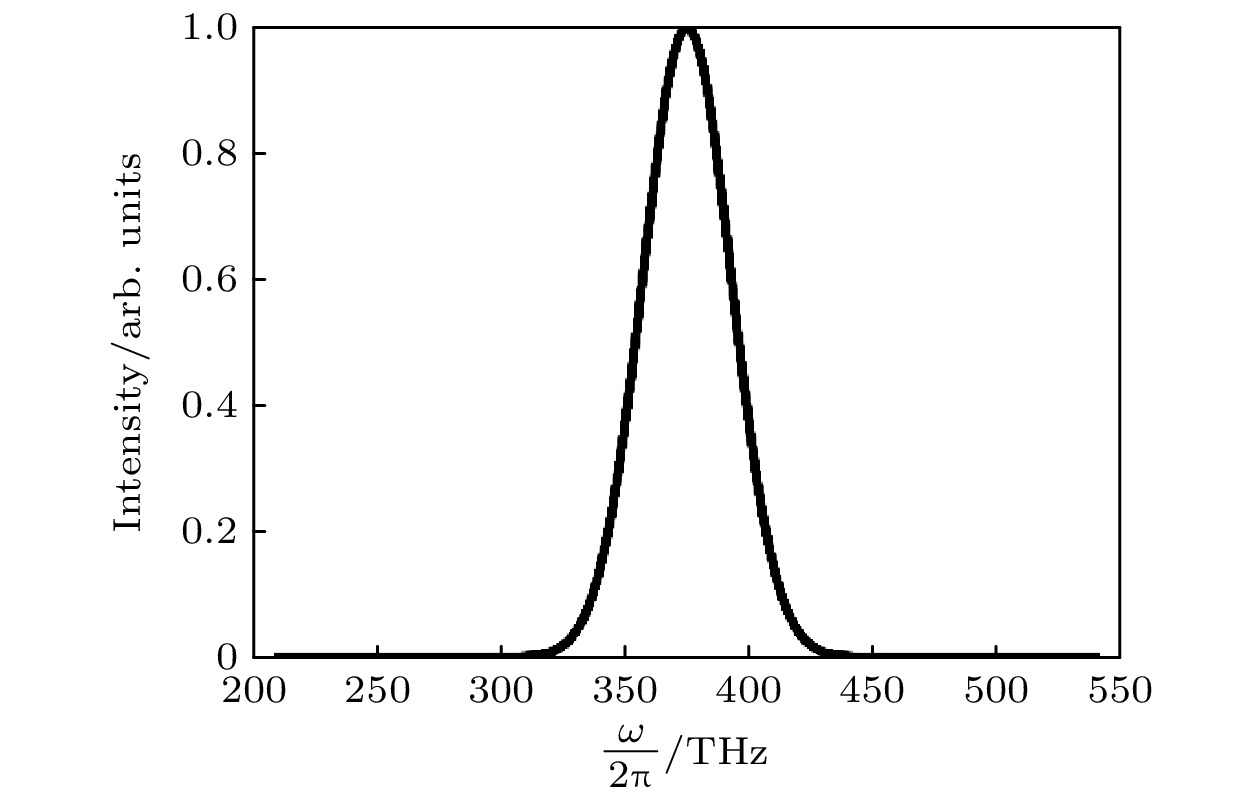
2021, 70 (9): 090601.
doi: 10.7498/aps.70.20201731
Abstract +
Frequency-resolved optical gating (FROG) is a common technique of ultrashort pulse measurement. It reconstructs the test pulse by an iterative two-dimensional phase retrieval algorithm from a FROG trace. Now the most widely used FROG algorithm is principal component generalized projection (PCGP), yet its accuracy of pulse retrieval drops obviously under noise condition, and its iterative speed slows down significantly as the size of FROG trace increases. Actually, most of ultrashort pulses delivered from ultrafast oscillators and amplifiers as well as created in most scientific experiments are of smooth spectral phases, so that they can be determined by a few of dispersion coefficients. In this paper, we propose a FROG algorithm based on seeker optimization algorithm (SOA). After recording the spectrum of the test pulse, several main dispersion coefficients of the spectral phase of the pulse are searched directly by the SOA algorithm to fit the corresponding FROG trace. Then the shape of the test pulse can be uniquely reconstructed. Since this algorithm mainly operates in a spectral domain and its routine of iteration is much simpler than PCGP’s, faster speed and higher accuracy of pulse retrieval can be expected. In order to prove the advantages of SOA-FROG algorithm, numeral simulations are performed for test pulses with varying dispersion, in the cases without noise and with 1%, 5%, 10%, 20% noise levels, respectively. The simulation results show that the new algorithm performs much better than PCGP in accuracy and iteration speed. In the case without noise, 97% test pulses reach the condition of rigid convergence (FROG error G ≤ 10–4) after 1500 iteration circles by using the SOA, with an average FROG error G < 10–5. So the accuracy of pulse reconstruction by SOA is at least three orders of magnitude higher than by PCGP. In cases with different noise levels, the accuracy of pulse reconstruction by SOA is also much higher than by PCGP. By means of background-subtraction and filtering on the FROG traces, the retrieved pulse profiles almost accord with reality. Typically for a 256 × 256 FROG trace, SOA-FROG iterates 100.8 circles per second, about 5 times faster than PCGP. After 300 iteration circles by SOA in about 3 s, most of test pulses can finish their routines of reconstruction and reach high accuracy. Besides SHG-FROG, the SOA-FROG algorithm can also be utilized in other FROG techniques based on the 3rd order nonlinear optical effects. In summary, the SOA-FROG is expected to be suitable to the real-time pulse measurement with high accuracy in most of application cases. Yet some measures of improvement should be taken to reconstruct complex pulses with rough spectral phases or/and broken spectra.
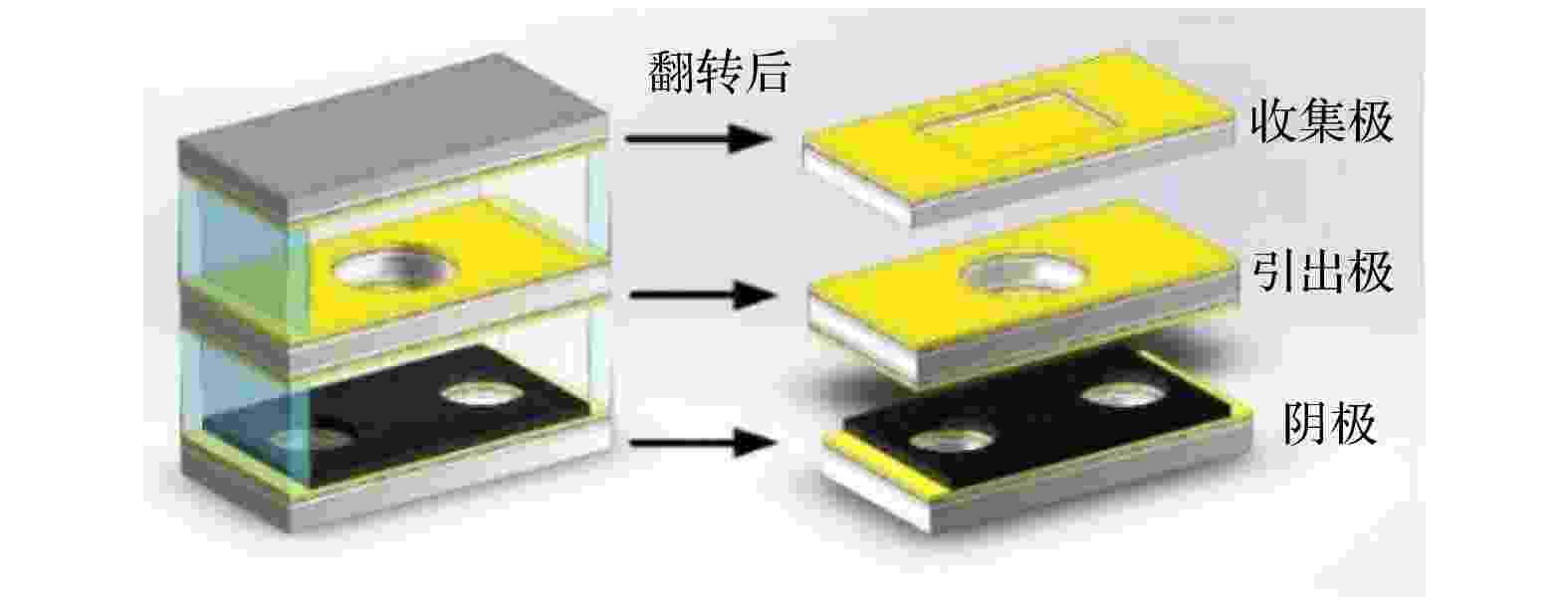
2021, 70 (9): 090701.
doi: 10.7498/aps.70.20201828
Abstract +
Compared with the traditional ionization sensor, triple electrode ionization gas sensor based on carbon nanotubes features excellent performances of small size and low operation voltage, and plays an important role in developing smart grids and the ubiquitous Internet of Things. However, they exhibit the disadvantages of small collecting current and low sensitivity, and need to be optimized in structure. Based on the Townsend discharge mechanism and three governing equations of particle mass conservation, electron energy conservation and Poisson equations, a two-dimensional plasma discharge fluid simulation model of the sensor is established by using the COMSOL Multiphysics software. According to gas composition, component concentration, structure of the sensor and voltage applied to the electrodes, we determine the chemical reaction, reaction rate coefficient, field control equation, initial values and boundary conditions. In order to calculate the interior distribution of charged particles inside the boundary, the inter-electrode space region is meshed. Initial values of mesh are set, such as a dense mesh of nano-meter length around the electrode having micro-nano structure, and a rough mesh of micro-meter length in the other region of inter-electrode space. The initial values of time-step are set for each mesh grid, and the discharge model of each mesh grid is numerically solved by the finite volume method. The three linkage governing equations are discretized and calculated iteratively in time and space, and the mesh values and time-steps are adjusted to make the results converged. The electrostatic field distribution and the average collecting current density of the eight kinds of sensors are obtained in the background gas of nitrogen. The optimal sensor structure is obtained by comparing the electric field intensities and current densities under different structure parameters. The eight kinds of the sensors are prepared for experimentally verifying the optimization method. The optimal structure of the 7# sensor has the highest collecting current density in the eight kind structures, which is consistent with the simulation results, and proves the feasibility of the structure optimization method proposed in the paper. Based on the optimal structure, the sensors, respectively with the electrode spacings of 100 and 120 μm, are fabricated, and the response characteristics of NO/SO2 mixture gas are obtained. Compared with other technologies, the sensor with optimal structure exhibits 1-2 orders of sensitivity higher than the others. The optimized triple electrode ionization sensor based on carbon nanotubes exhibits many potential applications.
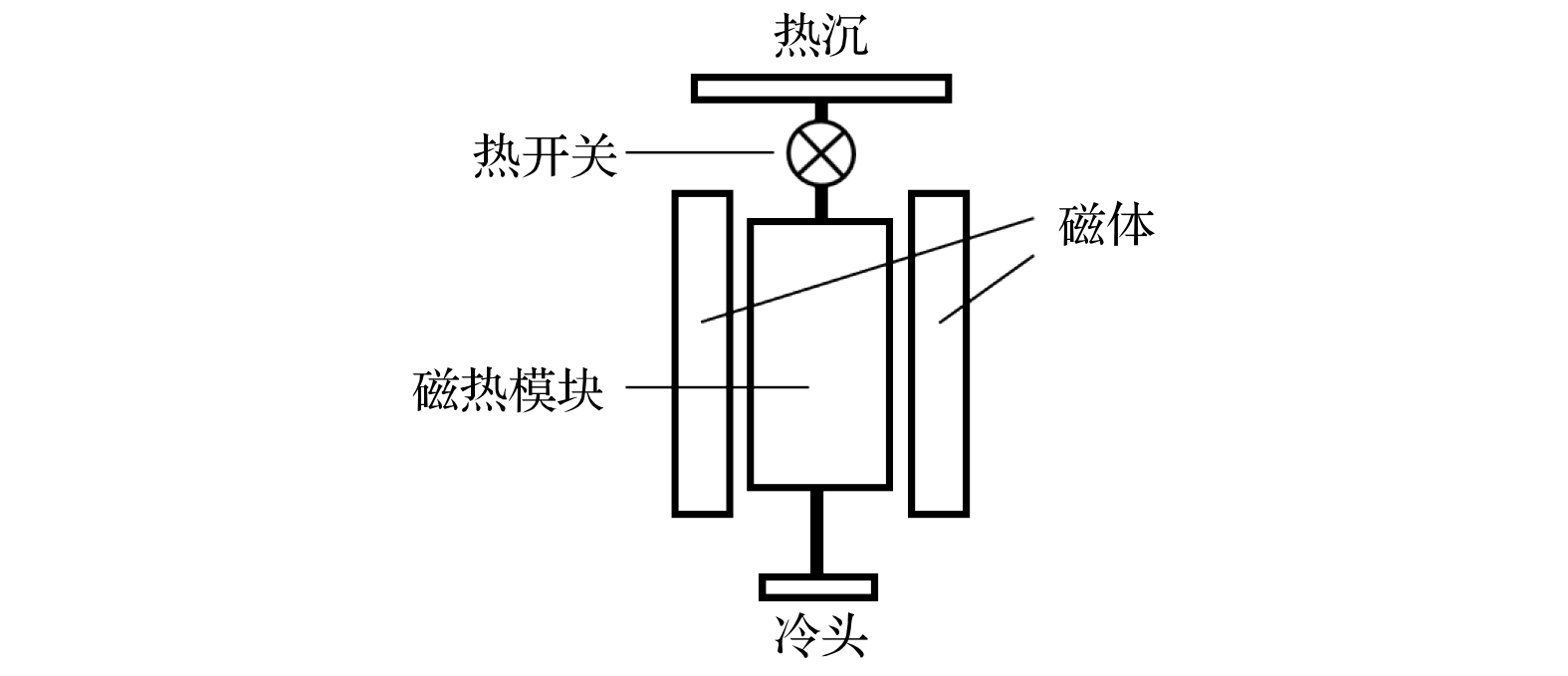
EDITOR'S SUGGESTION
2021, 70 (9): 090702.
doi: 10.7498/aps.70.20202237
Abstract +
ELECTROMAGNETISM, OPTICS, ACOUSTICS, HEAT TRANSFER, CLASSICAL MECHANICS, AND FLUID DYNAMICS

2021, 70 (9): 094201.
doi: 10.7498/aps.70.20201299
Abstract +
Quantum entanglement is an essential quantum resource. With the development of quantum information science, quantum network consisting of quantum nodes and quantum channels has attracted extensive attention. The development of quantum information network requires the capability of generating, storing and distributing quantum entanglement among multiple quantum nodes. It is significant to construct the quantum information, and it has very important applications in the distributed quantum computation and quantum internet. Here we propose a simple and feasible scheme to deterministically entangle three distant atomic ensembles via the interference and feedforward network of the light-atom mixed entanglement. Firstly, three atomic ensembles placed at three remote nodes in a quantum network are prepared into the mixed entangled state of light and atomic ensembles via the spontaneous Raman scattering (SRS) process. Then, the first and second Stokes optical field are interfered on an R1∶T1 optical beam splitter (BS1), and one of the output optical fields from the first optical beam splitter is interfered with the third Stokes field on the second R2∶T2 optical beam splitter (BS2). The quantum fluctuations of the amplitude and phase quadratures of these three output optical fields from BS1 and BS2 are detected by three sets of balanced homodyne detectors, respectively. Finally, the detected signals of the amplitude and phase quadratures are fed to the three atomic ensembles via the radio frequency coils to establish the entanglement among three remote atomic ensembles. At the user-controlled time, three read optical pulses can be applied to these three atomic ensembles to convert the stored entangled state from the atomic spin waves into the anti-Stokes optical fields via the SRS process. According to the tripartite inseparability criterion, the correlation variance combinations of these three anti-Stokes optical fields can be used to verify the performance of entanglement of three atomic ensembles. This scheme can be extended to larger-scale quantum information network with different physical systems and more atomic nodes. Moreover, the entanglement distillation can be combined with this scheme to realize the entanglement among longer distance quantum nodes.

2021, 70 (9): 094202.
doi: 10.7498/aps.70.20201353
Abstract +
Ultra-short pulse (picosecond) anti-Stokes laser can be obtained by using Raman frequency converter in a crystal medium by the coherent anti-Stokes Raman scattering effect. The crystalline Raman frequency converter based on the pump-probe method can realize the collinear interaction of coherent anti-Stokes Raman scattering, thus effectively improving the conversion efficiency of the anti-Stokes light. Theoretical simulation is an important means to study laser operation. Coupled wave equation is widely used to study the characteristics of Raman laser and anti-Stokes laser. Although the coupling wave theory of anti-Stokes Raman frequency shifter reported previously can reflect the operation law of the frequency shifter, the optimization of the frequency shifter and the influence of the frequency shifter parameters on the output characteristics of anti-Stokes laser have not been reported so far. In this paper, the picosecond anti-Stokes Raman frequency converter based on the pump-probe method is studied theoretically. Considering the generation of the first Stokes light in the probe channel and the second Stokes light in the pump channel, the coupled wave equation of the collinear picosecond anti-Stokes Raman frequency converter is established under the plane wave approximation. Without loss of generality, four dimensionless comprehensive parameters are introduced to normalize the equations. A set of universal theoretical curves describing the operation of the Raman frequency converter is obtained. The numerical solutions of the equations show that the performance of the Raman frequency converter mainly depends on three parameters: the normalized phase mismatch parameter ΔK, the normalized Raman gain coefficient G, and the energy ratio of the probe light to the fundamental light rprobe. The reasonable values of normalized variables are determined when the high efficiency anti-Stokes conversion is realized. Experimental data are used to verify the correctness of the theoretical model. The theoretical value of the anti-Stokes conversion efficiency is basically consistent with the literature data. The normalized coupled wave theory proposed in this paper is helpful in understanding the operation law of the picosecond anti-Stokes Raman frequency shifter, and has guiding significance for the design of the frequency converter.
PHYSICS OF GASES, PLASMAS, AND ELECTRIC DISCHARGES
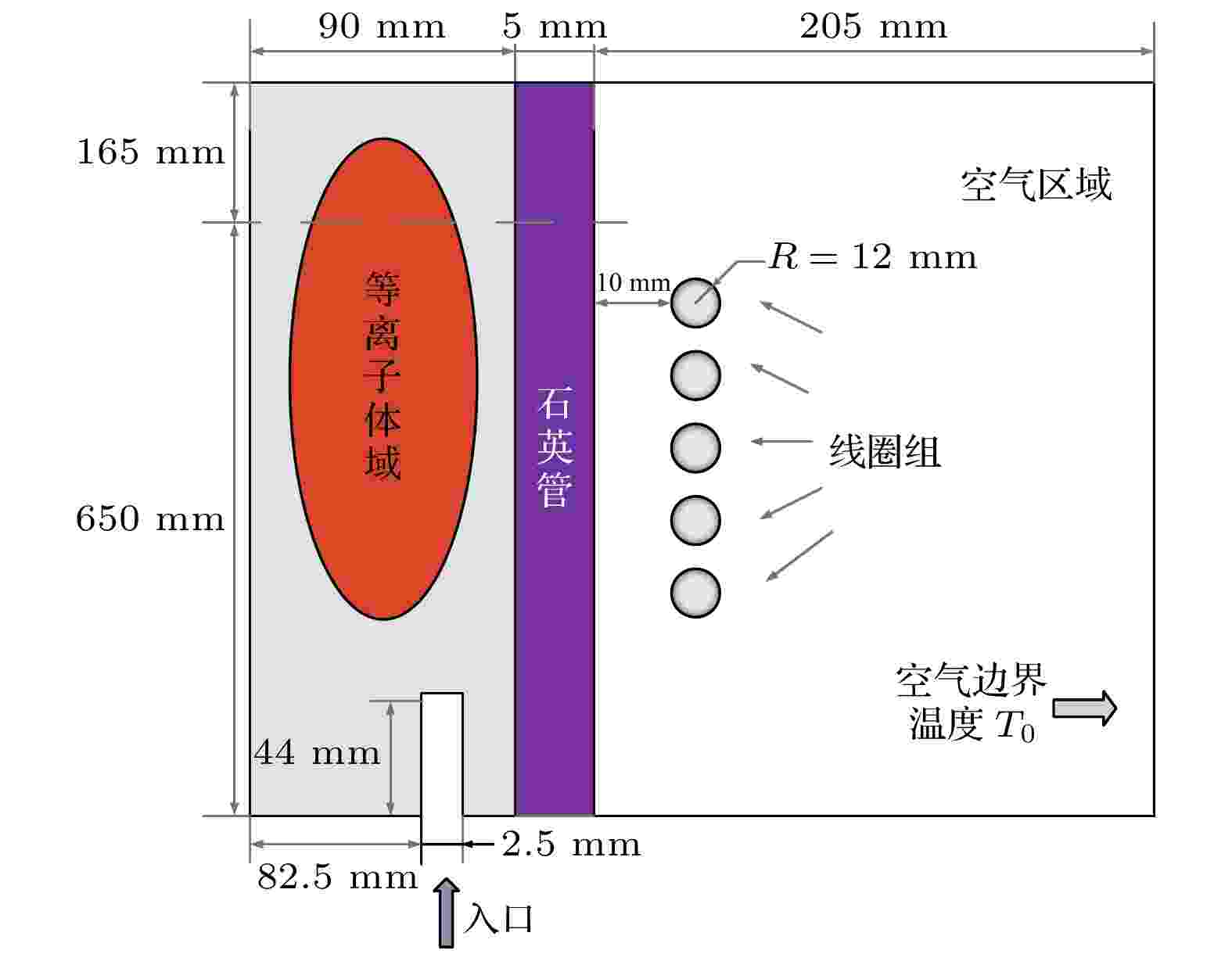
2021, 70 (9): 095204.
doi: 10.7498/aps.70.20201610
Abstract +
Inductively coupled plasma generator is one of the core components of the near-space high-speed target plasma electromagnetic scientific experimental research device, which is often used to simulate high enthalpy and high speed plasma sheath environment. In order to study the discharge characteristics of inductively coupled plasma generator under high power, radio frequency and medium pressure, the numerical simulation and experiment are combined to study its internal heat transfer and flow characteristics in this paper. Based on the local thermodynamic equilibrium conditions, the numerical simulation of large-scale radio frequency and medium pressure inductively coupled plasma with a power of 100–400 kW is carried out through the multi-field coupling of flow, electromagnetic and temperature field, and verified by light intensity and spectrum experiment. The results show that the electromagnetic field distribution in the high-power thermal balance inductively coupled plasma generator is similar to that of the small- and medium-sized power plasma generator. The discharge energy dissipation occurs mainly in the area where the induction coil is located. The temperature of the inner wall of the quartz tube is higher at the coil location than in other areas, and the plasma has a ring-shaped high-temperature structure. The outer wall of the quartz tube is set to be the boundary condition of heat flux for simulating the temperature change of the quartz tube under cold blowing. This setting is in coincidence with factual situations. The wall temperature of the quartz tube at the entrance and at the induction coil section are found to be relatively high. When the large-size inductively coupled plasma generator works, an obvious return vortex is generated at the entrance due to the temperature difference and the electromagnetic pumping effect, and the exit velocity increases slightly with the increase of power. At the same time, the discharge experiment under the corresponding conditions shows that there is found a ring structure with bright edges and dark centers in the axial image of the argon discharge. Moreover, the emission spectrum of argon plasma is measured through the spectrum diagnosis system and the spatial distribution of the generator electron temperature is obtained. The light intensity of the discharge image and the electron temperature measured by the spectrum are found to be in comparative coincidence with the COMSOL simulation temperature result, demonstrating the validity of the numerical simulation results under thermodynamic equilibrium conditions. The numerical simulation results in this paper are also applicable to the optimization design and temperature resistance evaluation of the inductively coupled plasma generator.
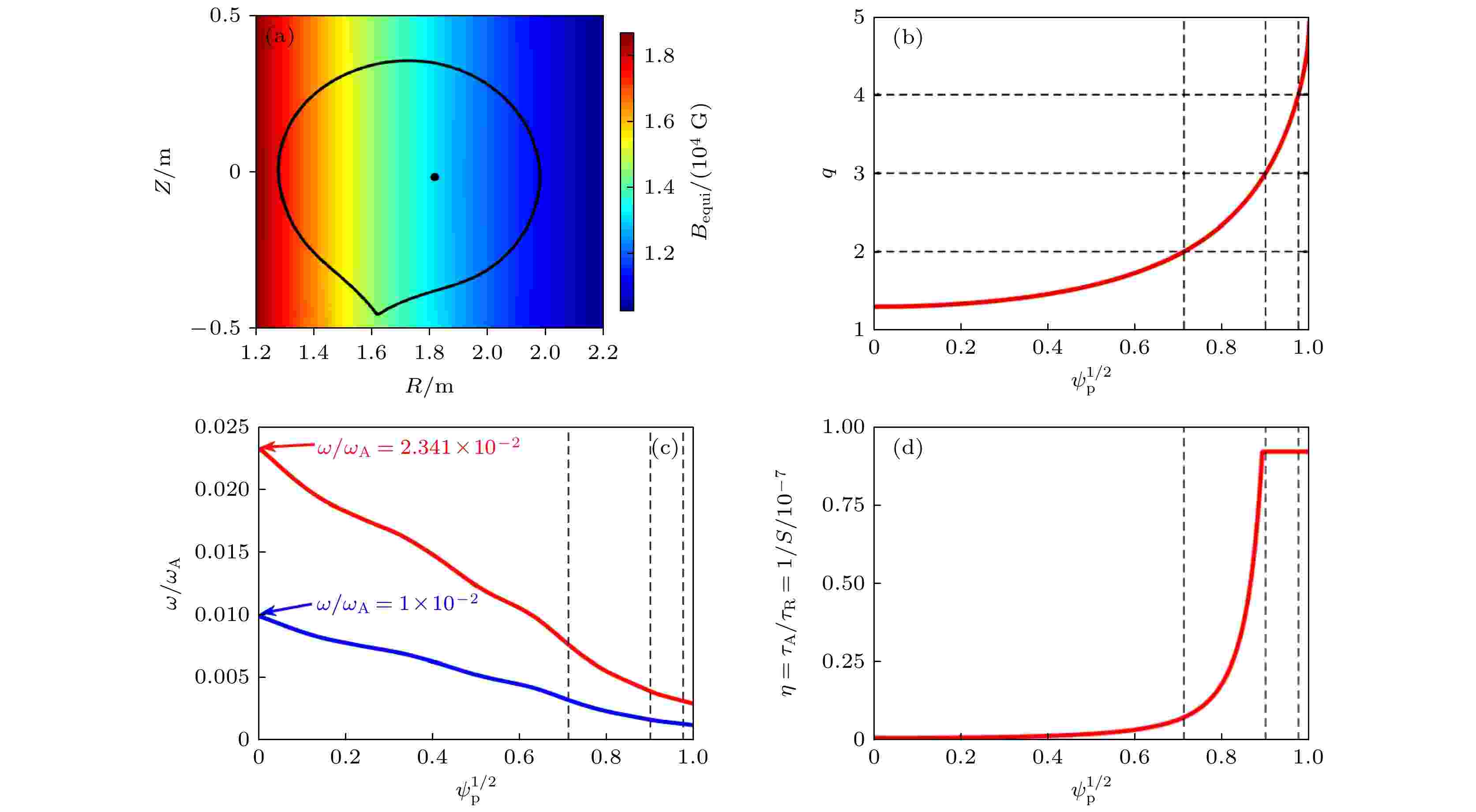
2021, 70 (9): 095207.
doi: 10.7498/aps.70.20201860
Abstract +

2021, 70 (9): 095209.
doi: 10.7498/aps.70.20201727
Abstract +
In the insulation system of power equipment, the partial discharge (PD) of short period does not cause the insulation to produce the penetrating breakdown, however the long-term PD of is one of the important causes of local deterioration, and even breakdown in dielectric. Therefore, it is very important to study the location of PD source and the calibration of discharge intensity. To achieve this, in this paper we take the needle-plate discharge model for example and go through the following steps respectively. Firstly, combined with the positive correlation between the ultrasonic signal and the apparent discharge magnitude in the process of PD, the ultrasonic method to detect partial discharge can be implemented. Then, based on the principle of time difference of arrival method (TDOAM), the accuracy of location is analyzed by using quantum genetic algorithm (QGA), genetic algorithm (GA), simulated annealing algorithm (SAA), particle swarm optimization (PSO) and generalized cross correlation method (GCC), respectively. And thus, starting from the study of the attenuation effect of sound pressure caused by the propagation loss, reflection and refraction of acoustic wave, the calibration model of PD intensity is established for the first time after determining the location of PD source with high precision. Some important findings are extracted from simulations and experimental results. First, the localization algorithm of PD source with high precision is observed. The localization of PD source by means of QGA is the most accurate, with maximum deviation of (0.27 ± 0.13) cm. Comparing with GA, SAA, PSO and GCC, the accuracy of location is improved by 33.57%, 41.51%, 32.11% and 87.26%, respectively. Second, due to the attenuation effect of sound pressure, when the measured voltage amplitude of ultrasonic signal is the same, the apparent discharge magnitude of PD source gradually increases with the test distance increasing. When the test distance is 37.80 cm, the apparent discharge magnitude of PD source is 633.83 pC, which increases by 28.51% compared with 7.00 cm. Moreover, simulation results and measurement results are compared with each other and they are well consistent. The discharge curve almost coincides with the calibration fitting curve of PD source when the test distance is 7.00 cm. Finally, it is concluded that the discharge intensity calibration model of PD source is accurate, which is of great significance in evaluating the extent of insulation damage.
CONDENSED MATTER: STRUCTURAL, MECHANICAL, AND THERMAL PROPERTIES

EDITOR'S SUGGESTION
2021, 70 (9): 096301.
doi: 10.7498/aps.70.20201888
Abstract +
Based on the first principles calculations, the effects of substitutional doping of nitrogen, halogen and 3d transition metal elements on the electronic structure of monolayer Janus transition metal dichalcogenides WSeTe are studied in this paper, where the VASP software package is used based on density functional theory to perform calculations through using both the projector augmented wave method and the GGA-PBE functional method. A monolayer WSeTe hexagonal crystal system with 4 × 4 supercells is established, which contains 48 atoms. When VA (VIIA) element substitutes for monolayer WSeTe, one of the Se atoms is replaced with a nitrogen (halogen) atom; when the 3d transition metal element substitutes for monolayer WSeTe, one of the W atoms is replaced with a transition metal atom. Through the analysis of band structure, charge transfer and magnetism, it is found that VA (VIIA) nonmetallic elements doped monolayer WSeTe due to the introduction of the hole (electronic) doped, makes the Fermi level shift downward (upward), thus transforming into a p(n) type semiconductor. The Ti and V element substitutional doped monolayer WSeTe will present semiconductor-metal transformation. A doping for each of Cr, Co, Mn, Fe element doesn’t lead semiconductor material properties to change, but the each of Co, Mn, Fe element doped monolayer WSeTe can create a band gap of less than 20 meV. The VIIA (VA) non-metallic element and 3d transition metal element doped monolayer WSeTe will not have a huge influence on the original geometric structure of the material. Due to the charge transfer and doped atoms on the top of the valence band hybridization phenomenon, the Rashba spin splitting intensity near the Γ point of the top valence band increases with the increase of the atomic number of the doped atoms in the same main group when VIIA and VA non-metallic elements are doped. Moreover, the increase in atomic number and charge transfer have a greater influence on the strength of Rashba spin-orbit coupling than the change in electronegativity. The 3d transition metal element substitution doped single-layer WSeTe has obvious spin polarization phenomenon, which produces valley polarization near the Fermi level and introduces magnetism. In particular, since Cr-doped WSeTe retains the original semiconductor properties of WSeTe and has a large energy valley polarization, it may have a wide range of applications, such as in the field of spintronic devices. The monolayer WSeTe doped separately with Cr, Mn and Fe element produces an impurity band with fully polarized spin electrons in the band gap. The results are of great significance in systematically understanding the properties of monolayer WSeTe doping model and can provide theoretical reference for designing the monolayer WSeTe based electronic devices.
CONDENSED MATTER: ELECTRONIC STRUCTURE, ELECTRICAL, MAGNETIC, AND OPTICAL PROPERTIES
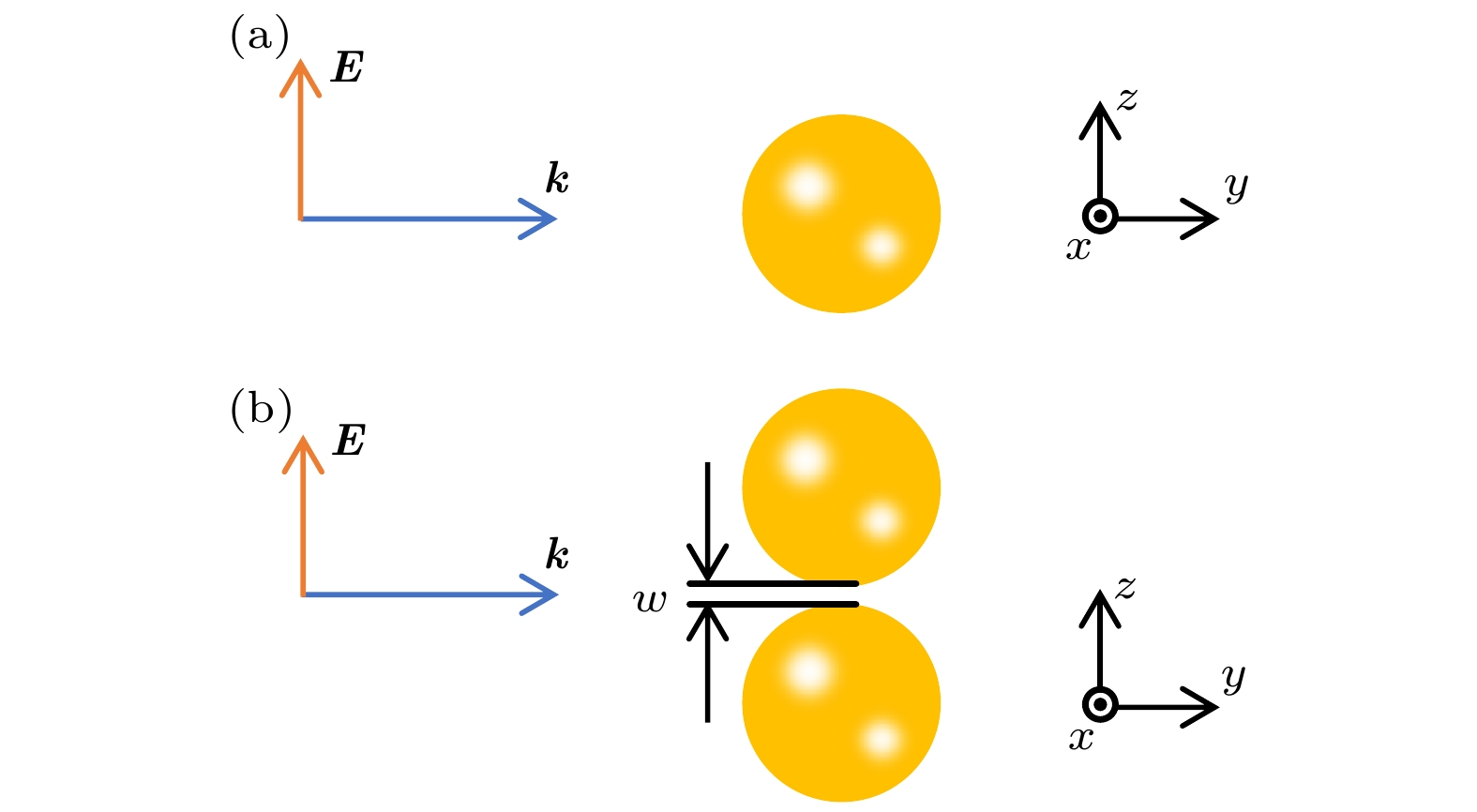
EDITOR'S SUGGESTION
2021, 70 (9): 097301.
doi: 10.7498/aps.70.20210231
Abstract +
In this paper we systematically study the optical extinction, local field enhancement, and resonance peak shift of basic single/double gold nanosphere system. We find that in the double gold nanosphere system, the incident light can excite the coupled resonance modes when the two gold nanospheres are approaching to each other, leading the local field to be enhanced greatly. Interestingly, limited by the scant volume of local field, the extinction coefficient of the double gold nanosphere system of 2 nm gap with a high local field enhancement factor is greatly reduced, so that its optical sensing sensitivity and extinction coefficient are smaller than the 5 nm gap system’s. Studies show that the optical sensing sensitivity of the double gold nanosphere system is not directly determined by the local field enhancement amplitude, but has a similar change behavior to the extinction coefficient of the system. These results can offer us a useful route and hint for designing the gold nanoparticle systems used in the surface Raman scattering enhancement and high performance optical sensing.
INTERDISCIPLINARY PHYSICS AND RELATED AREAS OF SCIENCE AND TECHNOLOGY
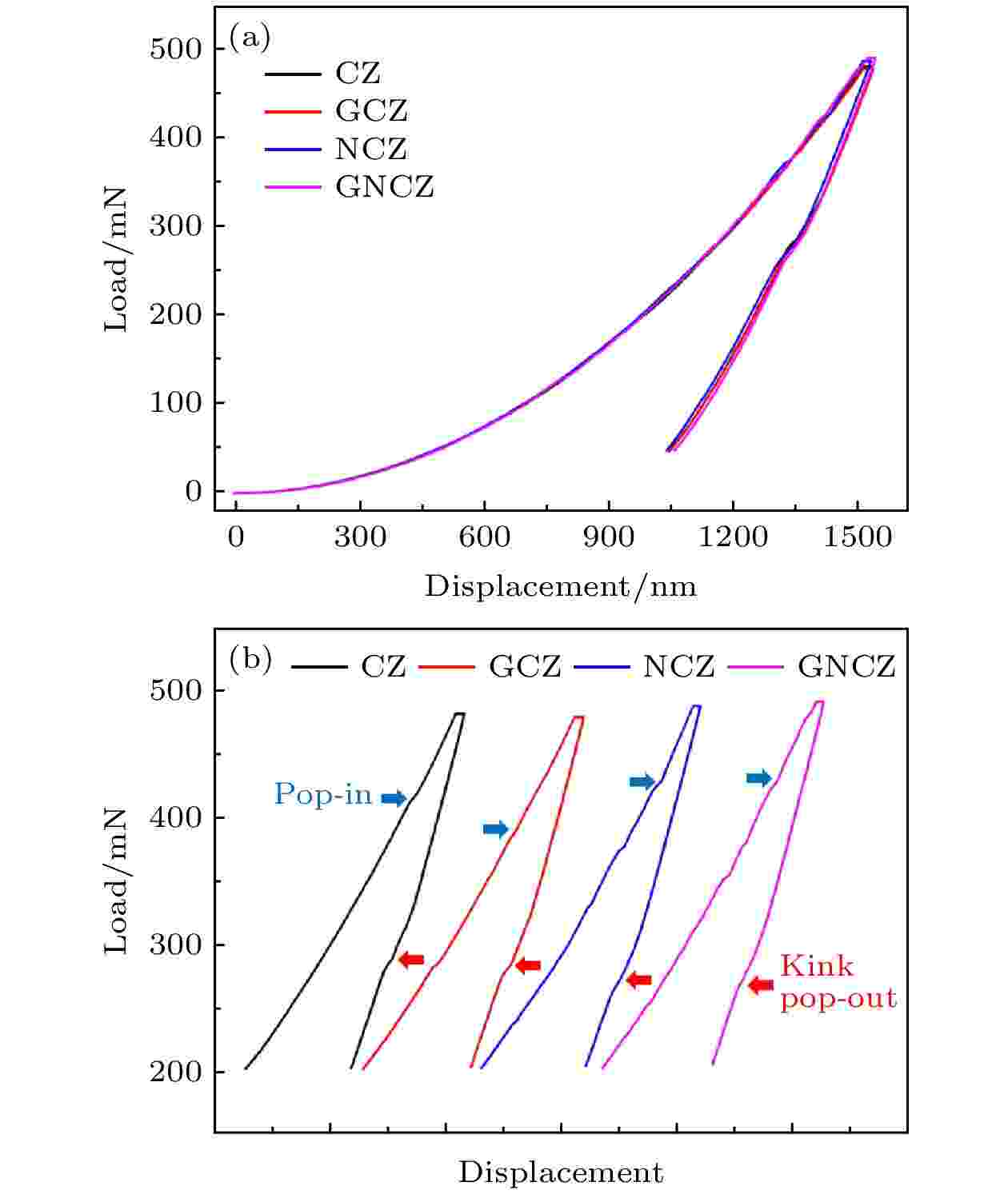
EDITOR'S SUGGESTION
2021, 70 (9): 098101.
doi: 10.7498/aps.70.20201803
Abstract +
Czochralski (CZ) silicon is a base material for manufacturing integrated circuits (ICs). The mechanical strength of CZ silicon determines the processing limitations and often dominates the issues related to packaging and failure of ICs. With the ever-smaller feature size of ICs, the scaling of device dimensions may indirectly lead to increase the stress in silicon substrate, thus increasing the probability of generating dislocations. Consequently, improving the mechanical strength of CZ silicon is of significance for increasing the manufacturing yield of ICs. In this work, we propose a strategy of co-doping germanium (Ge) impurity and nitrogen (N) impurity into CZ silicon to achieve better mechanical strength. In order to explore the feasibility of such a strategy, we comparatively investigate the room-temperature hardness and dislocation gliding behaviors in the temperature range of 600–1200 ℃ in the conventional CZ silicon, Ge-doped CZ silicon, N-doped CZ silicon, as well as N and Ge co-doped CZ silicon. The significant experimental results are described as follows. 1) Ge-doping, N-doping or co-doping of Ge and N hardly influences the hardness and therefore the dislocation gliding behavior at room temperature. 2) The suppressing effect of N-doping on the dislocation gliding is remarkable at 600–1000 ℃ and becomes weakened at the temperatures higher than 1100 ℃, while Ge-doping hardly affects the dislocation gliding at 600–900 ℃ but exhibits a strong suppressing effect on the dislocation gliding at 1000–1200 ℃. 3) Co-doping Ge and N impurities into CZ silicon can take the complementary advantages of both Ge- and N-doping to suppress the dislocation gliding at 600–1200 ℃. It is believed that N-doping can result in the formation of N-O complex-related pinning agents within the dislocation cores to suppress the dislocation gliding at 600–1000 ℃. For Ge-doping, it is supposed that Ge-O complexes acting as the pinning agents can form near the front of a single dislocation when the temperature is as high as 1000 ℃ and above. In a word, it is verified in this work that co-doping Ge and N into CZ silicon can further improve the mechanical strength at the processing temperatures of ICs fabrication.

2021, 70 (9): 098201.
doi: 10.7498/aps.70.20201764
Abstract +
Because of the high water flux and excellent ion rejection, the pores graphene is considered as a promising candidate material for fabricating the membranes in reverse osmosis (RO) process. Unfortunately, water molecules cannot pass through the perfect graphene, and how to effectively create a large number of nanopores with controllable size remains a challenge, which seriously prevents the practical application and development of graphene membrane for desalination. Recently, the emergence of pillared graphene (PGN) might open a new way for designing the graphene-based membranes, which can compensate for the deficiency of porous graphene membrane. The PGN has been extensively studied in gas storage and separation, and its RO characteristics and mechanism still remain unclear because the limitation of large area preparation in desalination. In this paper, the RO process of seawater through PGN membranes is investigated by molecular dynamics simulations, and the influences of the pressure within feed solution, temperature and the shearing of membrane on the desalination properties are considered. It is found that the water flux increases linearly with the pressure within feed solution increasing, and the PGN membrane with nanopore diameter of 0.8 nm can conduct water molecules but completely rejects high-concentration ions. As the diameter of nanopores increases to 1.2 nm, the rise of temperature can increase the permeability of water molecules, whereas the salt rejection is not appreciably sensitive to the temperature. Particularly, the shearing membrane can improve the salt rejection and hinder the water molecules from permeating at the same time. The designed PGN membrane exhibits excellent performance of water purification, and the ultrahigh water flux obtained in this work reaches 56.15 L·cm–2·day–1·MPa–1 with a salt rejection of 88.9%. Subsequently, the hydrogen bond dynamics is calculated in order to explain the variation of water permeability under different conditions. The result shows that the rise of temperature reduces the stability of hydrogen bonds and leads the water flux to increase, while the increase of shearing speed will enhance the stability of hydrogen bonds and inhibit water seepage. Furthermore, the analysis results of hydrogen bond and ionic hydration structure show that the shear motion on RO membrane will improve the stability of ionic hydration shell, which makes it more difficult for the ions to pass through nanopores by weakening the hydration shell. On the contrary, rising temperature will impair the strength of ionic hydration shell, leading more ions to pass through the RO membrane. The simulation results can provide an in-depth understanding of the desalination performance of PGN membrane under different key conditions, and further demonstrate the promising applications of graphene-based membrane in water desalination.
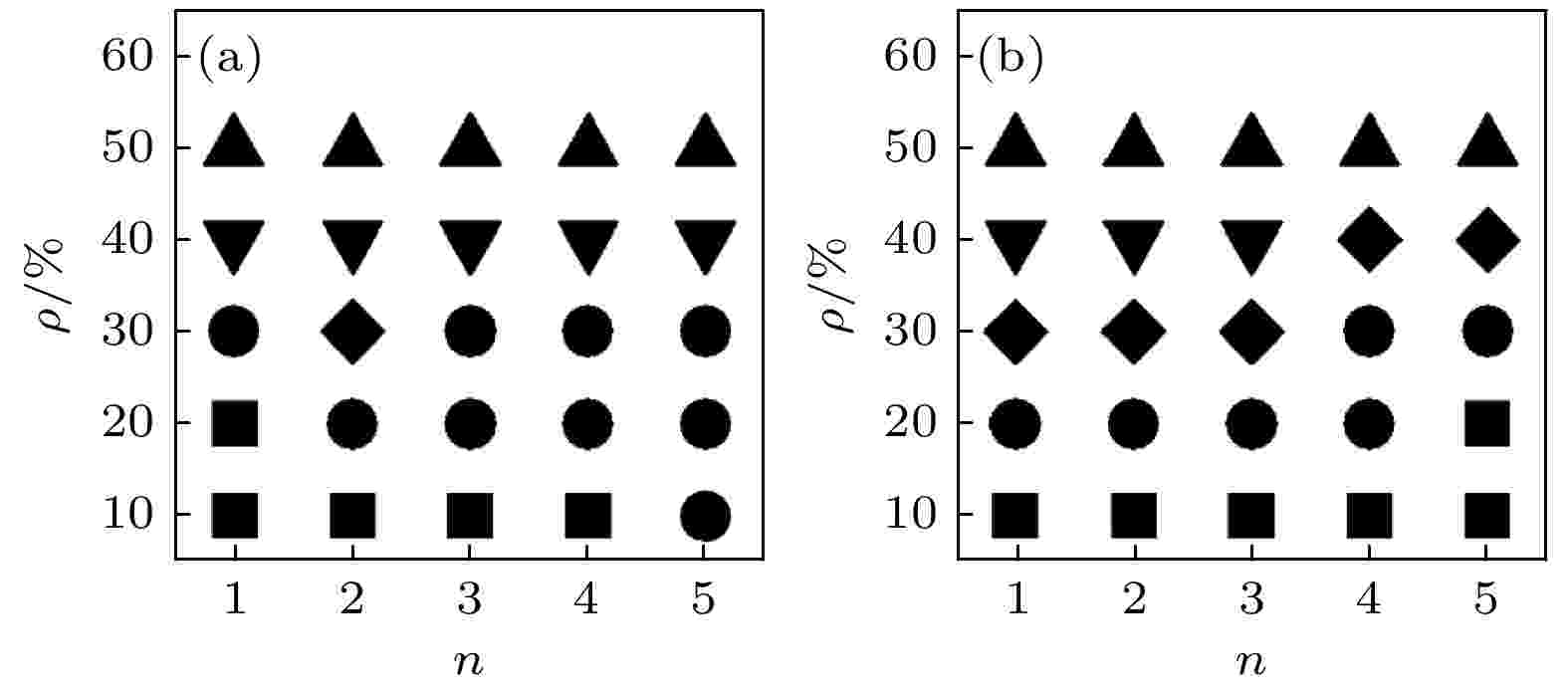
2021, 70 (9): 098202.
doi: 10.7498/aps.70.20201294
Abstract +
Cardiac arrhythmias can be caused by the occurrence of electrical spiral waves and spatiotemporal chaos in the cardiac tissues, as well as by the changes of cardiac tissues resulting from the electrical coupling of cardiomyocytes to fibroblasts (M-F coupling). How to control the arrhythmia induced by spiral wave or spatiotemporal chaos is the problem which has attracted much attention of scientists. In this paper, a two-layer composite medium is constructed by using cardiomyocytes and fibroblasts. Luo-Rudy phase I cardiac model and passive model of fibroblast are used to study the effects of the M-F coupling on the formation of spiral wave and the control of spiral wave and spatiotemporal chaos in a two-layer composite medium. A control scheme that the spiral waves and spatiotemporal chaos are controlled by increasing the coupling strength between cells is proposed. The numerical results show that the M-F coupling has an important influence on the dynamics of spiral wave. With the increase of the density of fibroblasts, the M-F coupling may result in spiral wave meandering and spiral wave breaking into spatiotemporal chaos, and even induce the transition from spatiotemporal chaos (or spiral wave) to no wave. The eliminating spiral wave and spatiotemporal chaos in the composite medium by increasing the coupling strength between cells is only effective in most of cases, depending on the role played by fibroblasts. When fibroblasts act as current sinks for the cardiomyocyte, the spiral wave and spatiotemporal chaos are effectively eliminated only in most of cases by increasing the coupling strength between cells, and the controlled area is small. When fibroblasts act as a current source for the cardiomyocyte, increasing the coupling strength between cells to a value higher than a critical value can effectively terminate spiral wave and spatiotemporal chaos, and the controllable area is greatly increased compared with the former. Increasing the coupling strength between cardiomyocytes is a key factor in controlling the spiral waves and spatiotemporal chaos.
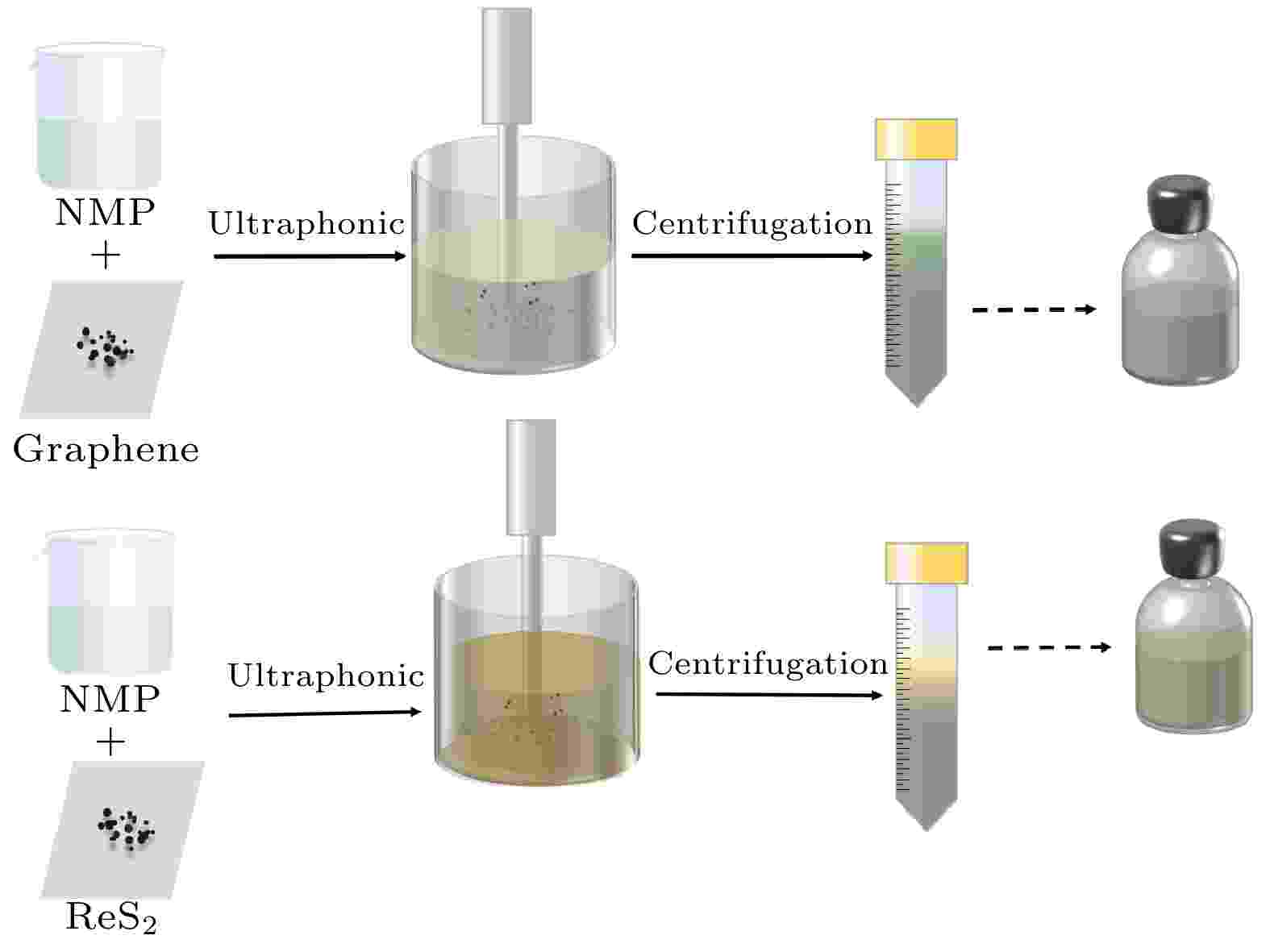
2021, 70 (9): 098203.
doi: 10.7498/aps.70.20201904
Abstract +
Energy and pollution are crucial problems. Photocatalysis technology is a way to solve the problem by electrolysis of aquatic hydrogen and degradation of organic pollutants. Preparing photocatalysts with fantastic photocatalytic activity and high photocarrier separation efficiency is a key technique. In recent years, two-dimensional (2D) nanomaterials have attracted much attention because of their unique structures and excellent properties, which are different from the traditional materials’. The 2D nanomaterials demonstrate in-plane covalent bonds and out-of-plane van der Waals interactions. Therefore, two 2D materials can form van der Waals heterojunctions by van der Waals forces, which are also known as nanocomposites. However, there is an interesting problem in the study of van der Waals heterojunctions in the field of photochemistry, which has not been paid attention to no studied. Specifically, that problem is whether the photochemical properties of the van der Waals heterojunctions are affected by the different stacking structures after the relationship between the upper and lower positions has been adjusted. In this paper, the van der Waals heterojunction films with different stacking structures ReS2-Gra (ReS2 on the top) and Gra-ReS2 (graphene on the top) are prepared by liquid phase exfoliation combined with electrophoretic deposition method. The heterojunctions are utilized as photoelectrodes in photochemical reactions, and the findings are as follows. i) Different stacking structures will affect the photoelectric chemical characteristics of heterojunctions: comparing with the ReS2-Gra photoelectrode, the photocurrent of the Gra-ReS2 photoelectrode increased by 54% under the same conditions. We think that the main reason is due to the fact that graphene has a zero-band gap structure and holds a wider spectral absorption range. ii) The construction of the heterojunction significantly enhances the photochemical properties of the photoelectrode materials, resulting in a larger and rapidly photocurrent response. The photocurrent response of the Gra-ReS2 photoelectrode (2.47 μA) is twice that of the pure ReS2 photoelectrode (1.16 μA). Based on the experimental results of this paper, a possible mechanism for effective separation and prolonged recombination of the photo-induced electro-hole pairs in ReS2/graphene heterojunction is proposed. This work not only puts forward new ideas for preparing the van der Waals heterojunctions, but also lays a theoretical foundation for further studying the solar energy conversion devices.

2021, 70 (9): 098301.
doi: 10.7498/aps.70.20201145
Abstract +
After high pressure shock, the shock wave in the metal is unloaded at the metal-gas interface, and micro spallation occurs when the metal melts. When the micro spallation develops to a certain extent, the high pressure gas penetrates the zero pressure vacuum gap between the metal melt droplets. In this paper, the phenomenon of gas penetrating metal micro spallation zone is analyzed theoretically. Based on the regular hexahedron periodic arrangement of metal droplets, the calculation formulas of the maximum penetration depth, the sealing time of the penetration channel and the maximum mass of the gas penetrating the metal micro spallation zone are given through theoretical analysis under the quasi-static and semi-dynamic conditions. The quasi-static process is considered to be the gas penetration process that can be approximated as the escape process of gas into the vacuum, and the gap in the metal micro spallation zone will be filled with gas. The semi-dynamic analysis is based on two basic assumptions: one is the equal droplet size and spacing in the micro spallation zone and the other is the critical sealing condition of gas penetration. In the process of semi-dynamic analysis it is demonstrated that the initial critical sealing distance is independent of the shape factor of the droplet single control volume. The semi-dynamic analysis can give various critical sealing information when the gas stops penetrating the metal micro spallation zone. The results of quasi-static analysis can be used as the upper limit of gas penetration, and the semi-dynamic analysis results can be used as the lower limit of gas penetration. From the sensitivity analysis, it can be seen that the change law of physical phenomena given by theoretical analysis accords with the basic physical understanding of the problem. Through this study, the upper and lower limit of the mixed state of gas penetrating the metal micro spallation zone can be estimated, which can provide more accurate initial metal-gas mixed state for subsequent research of the evolution of mixed state. The theoretical analyses given in this paper are based on a lot of uncertain assumptions, and the in-depth study of this phenomenon is still needed based on the law summary and mutual confirmation of experiment and simulation.

2021, 70 (9): 098401.
doi: 10.7498/aps.70.20201850
Abstract +
At present, researchers generally believe that the change of maximum directivity of planar phased arrays in beam scanning process conforms with the cosine law, so that the wide-range beam scanning from broadside to end-fire is impossible to realize. There are three main factors that affect the scanning range of the planar phased array antenna: 1) array factor; 2) element pattern; 3) port impedance matching. Scholars have done a lot of researches on the element pattern and the port impedance matching. About the array factor, Elliott, a famous phased array scholar, made a theoretical study on the directivity of the linear array and the planar array in 1963 and 1964, concluding that the variation of directivity of planar phased array conforms with the cosine law. However, the above conclusion came from an approximate formula under certain conditions: 1) the element pattern in the half-space is omnidirectional; 2) the beam of a large array is narrow enough; 3) the beam cannot scan a range of several beamwidths close to end-fire. To make clear the scanning beam’s change law of planar arrays, the law of directivity changing with scanning angle of linear array and planar phased array with different sizes are analyzed by using the strict formula of array factor, and the directivity’s change law derived from strict formula of array factor is compared with the cosine law. The results show that 1) the variation law of the directivity of a linear array depends on the spacing between elements. When the spacing between elements is equal to half a wavelength, the directivity of the array does not change with the scanning angle. When the spacing between elements is less than half a wavelength, the directivity of the array increases with scanning angle increasing. 2) The directivity of a finite array decreases with scanning angle increasing. However, the scanning beam’s maximum directivity of a finite planar phased array does not satisfy the cosine law and it is not zero in the end-fire range. Based on the above conclusions, the idea that the change of array factor’s directivity is compensated for by element beamforming is further proposed, which points out a direction for realizing the ultra-wide-angle-range beam scanning of planar phased arrays.
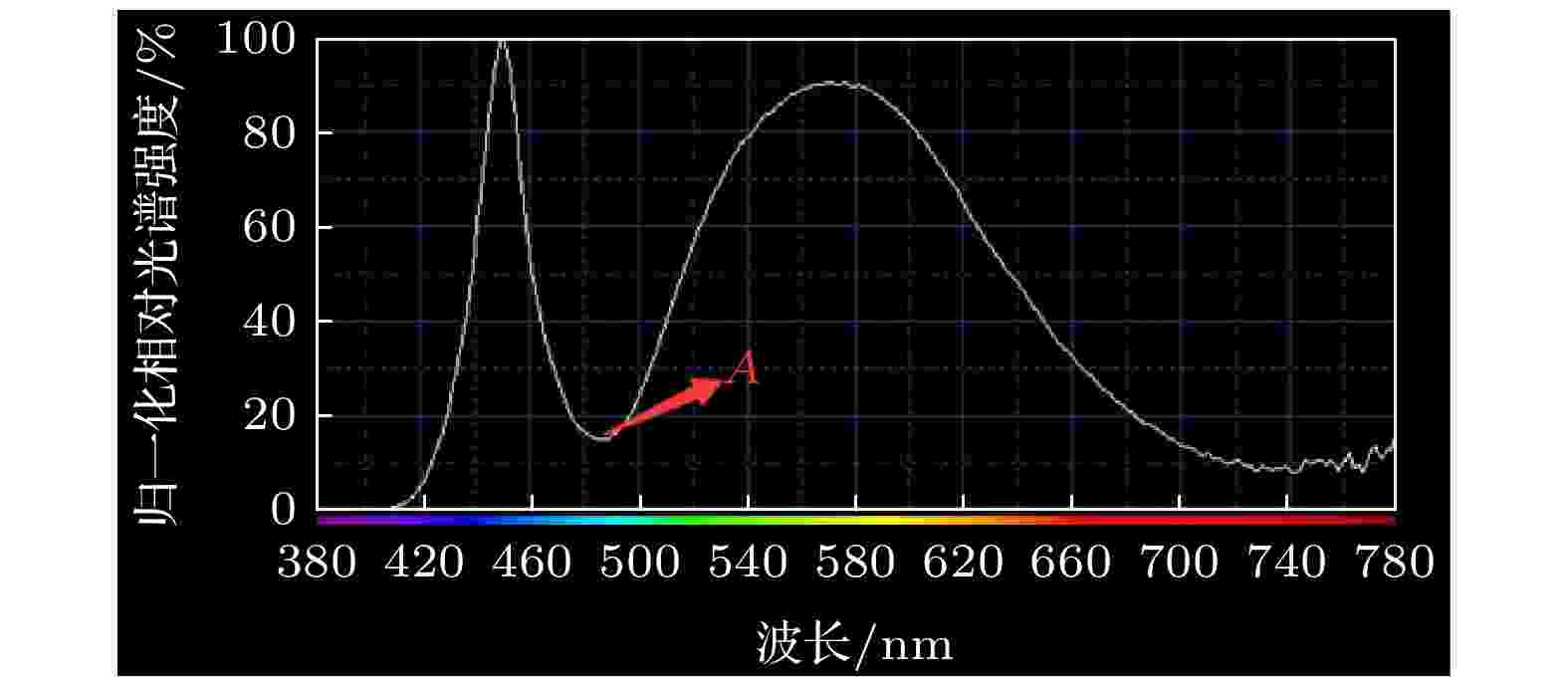
2021, 70 (9): 098501.
doi: 10.7498/aps.70.20201093
Abstract +
According to the luminous spectrum characteristics of white light emission diode (WLED) light emission spectrum, through the analysis of the intersection (the trough point of the whole spectrum) of blue light spectrum and yellow light spectrum generated by blue light excited yellow phosphor, in this paper we design an LED steady-state thermal resistance measurement system based on the spectroscopic method by using the conventional spectrometer, and we also use the normal driving current to fit the whole spectrum trough through a certain function algorithm. According to the temperature rise curve, we can calculate the temperature rise of the LED junction temperature relative to the substrate under any working condition, and combine the heat dissipation power of the LED to get the steady-state thermal resistance of the LED. This method avoids the limitation of a similar forward voltage drop method which uses the minimum current calibration and requires the modules of high-speed data acquisition and high-speed sampling conversion, thus making the equipment expensive. Therefore it is necessary to reduce its cost. Finally, the system designed in this paper and the T3Ster instrument of Mentor Graphics Corporation in the United States are both used to measure various LEDs and their results are compared with each other. The results show that the maximum deviation of steady-state thermal resistance is only 3.64%. It indicates that the system and method designed in this paper can achieve the same precision as T3Ster instrument of Mentor Graphics Corporation, demonstrating that the system and method designed in this paper can achieve the same precision as the T3Ster instrument of Mentor Graphics, under the condition without needing expensive equipment, Moreover, this method uses non-traditional spectral method to measure the junction temperature of LED, which has the characteristics of remote real-time online detection of LED junction temperature, low cost, and no restrictions on the LED packaging structure. Therefore, this method has a wider application range than the voltage method adopted by Mentor Graphics T3Ster equipment, and has a certain practical value.

2021, 70 (9): 098701.
doi: 10.7498/aps.70.20201797
Abstract +
Multifocal structured illumination microscopy (MSIM) can achieve a doubled improvement in the resolution of the diffraction limit within an imaging depth of 50 μm. But when imaging thick samples, scattered light and defocused light limit its optical sectioning capability and image contrast. Two-photon MSIM (2P-MSIM) overcomes the influence of sample tissue scattering and further improves the imaging depth and imaging characteristics. However, the existing 2P-MSIM usually adopts galvanometer based scanning mirrors for precisely scanning imaging, which is a complicated and poor flexibility system. Here we propose a simpler 2P-MSIM. Two-photon multifocal scanning imaging can be realized by a spatial light modulator (SLM) with a high frame rate (< 845 Hz). The phase map of generating multi-focus array and linear phase grating loaded on the SLM simultaneously, high-precision parallel digital random address scanning and excitation imaging on the sample surface can be realized. The mechanical inertia problem of the galvanometer scanner in multifocal imaging can be solved by the proposed method while reducing the complexity of the system and improving flexibility. We finally realize two-photon multifocal imaging of mouse kidney tissue slices and lily of the valley rhizome by this system, which verifies the three-dimensional super-resolution imaging capability of this method. It is of great significance in developing the 2P-MSIM.

EDITOR'S SUGGESTION
2021, 70 (9): 098801.
doi: 10.7498/aps.70.20201975
Abstract +
Perovskite solar cells have been attracting more and more attentions due to their extraordinary performances in the photovoltaic field. In view of the highest certified power conversion efficiency of 25.5% that is much lower than the corresponding Shockley-Queisser limit, understanding and quantifying the main loss factors affecting the power conversion efficiency of perovskite solar cells are urgently needed. At present, the three loss mechanisms generally recognized are optical loss, ohmic loss, and non-radiative recombination loss. Including the trap-assisted bulk recombination and surface recombination, the non-radiative recombination is proved to be the dominant recombination mechanism prohibiting the increase of efficiency. In this work, based on semiconductor physics, the expressions of bulk and surface recombination currents are analytically derived. Then taking the optical loss, series and shunt resistance losses, and bulk and surface recombination losses into considerations, an equivalent circuit model is proposed to describe the current density-voltage characteristics of practical perovskite solar cells. Furthermore, by comparing to the drift-diffusion model, the pre-defined physical parameters of the drift-diffusion model well agree with the fitting parameters retrieved by the equivalent circuit model, which verifies the reliability of the proposed model. For example, the carrier lifetimes in the drift-diffusion model are consistent with the recombination factors in the equivalent circuit model. Moreover, when the circuit model is applied to analyze experimental results, the fitting outcomes show favorable consistency to the physical investigations offered by the experiments. And the relative fitting errors of the above cases are all less than 2%. Through employing the model, the dominant recombination type is clearly identified and split current density-voltage curves characterizing different loss mechanisms are offered, which intuitively reveals the physical principles of efficiency loss. Additionally, through calculating the efficiency loss ratios under the open-circuit voltage condition, quantifying the above-mentioned loss mechanisms becomes simple and compelling. The prediction capability of the model is expected to be enhanced if a series of light intensity dependent current density-voltage curves are fitted simultaneously. Consequently, this model offers a guideline to approach the efficiency limit from a circuit-level perspective. And the model is a comprehensive simulation and analysis tool for understanding the device physics of perovskite solar cells.
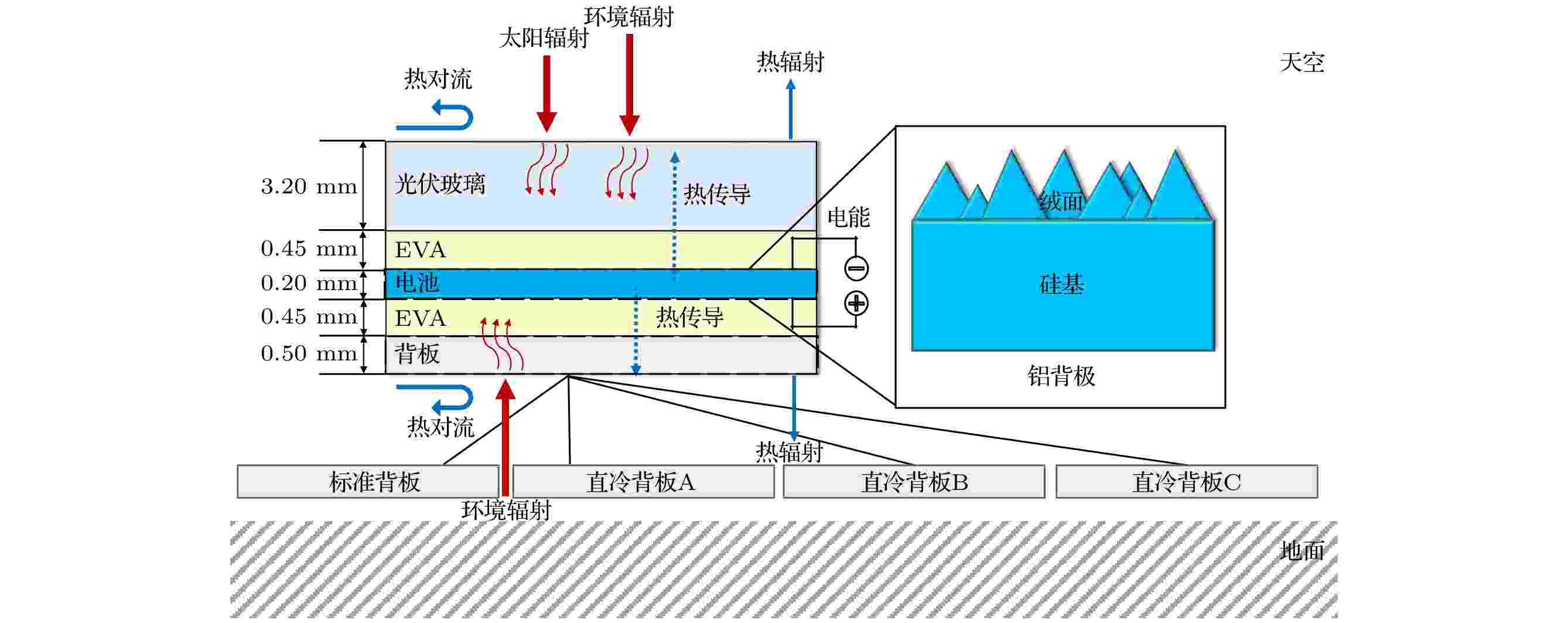
2021, 70 (9): 098802.
doi: 10.7498/aps.70.20201741
Abstract +
The working temperature of the crystalline silicon photovoltaic (PV) module seriously restricts the cell efficiency and the module lifetime. Therefore, it is of great significance to investigate the cooling effects of PV modules. Recently, introducing nanostructures into polymer backsheets to obtain direct-cooling effects due to enhanced heat conduction and radiation characteristics, has become a new trend for PV cooling technology. In this paper, we study the backside thermal properties of the PV module by combining the energy balance equation and optical simulations. The thermal power and cooling effect are calculated and compared between the standard backsheet and three types of direct-cooling backsheets for three typical ambient temperatures. The structure parameters and encapsulating mode of mainstream commercial silicon cells are adopted in the simulations and calculations. The influences of thermal parameters, i.e, the heat transfer coefficient and the emissivity, on the thermal process and the operating temperature are discussed in detail. We hope that this study may provide a certain reference for the future design of PV-direct-cooling backsheets.
GEOPHYSICS, ASTRONOMY, AND ASTROPHYSICS

2021, 70 (9): 099201.
doi: 10.7498/aps.70.20201779
Abstract +
Investigation of cloud microphysical is of great significance in deepening the understanding of the radiation energy budget, water cycle process, and precipitation mechanism, and improving the scientificity and effectiveness of artificial precipitation. Especially under the action of turbulence, in addition to shear and inertia, the turbulence in the cloud will accelerate the collision of cloud droplets through vortex superposition. The above process will further complicate the cloud microphysical characters. At present, the methods of measuring cloud microphysical parameters based on light scattering, collision and imaging theories encounter bottlenecks: the inversion process needs to make the assumptions about cloud droplet spectrum and particle characteristics, the impact process will destroy particle characteristics, and the three-dimensional characteristics of cloud particles cannot be obtained. Because of its many advantages, such as fast, real-time, non-destructive, non-invasive, high-resolution, full-field optical measurement, etc., in-line digital holographic interferometry is considered as a new potential tool for the dynamical measurement of cloud microphysical property. In particular, the mutual interference between the particle image and twin image is small under far-field recording conditions. In this paper, the measurement method of the on-line digital holographic interferometry based on interference theory, combining optical information processing, depth of field compression, and gray gradient variance technology of fusion holograms, is investigated. This method, with a z-axis position accuracy of 0.01 mm and system resolution of 2 μm, is employed for simultaneously and finely detecting the cloud droplet spectrum, cloud particle diameter, and number concentration. In the experiment, the liquid droplet with a median diameter of 3.9 μm, produced by the ultrasonic atomizer, is used as an example of the cloud particle. The measurement results are consistent with realistic scenario. By using a high speed charge coupled device or complementary metal oxide semiconductor camera, this method can solve the technical bottleneck of three-dimensional fine characteristics of cloud particle in airborne measurement by using cloud droplet spectrometer. It can provide effective support for the research of liquid water in the cloud, entrainment, condensation, collision, and temporal and spatial evolution laws. In addition, it has reference significance for the study of particle dynamics. Simultaneously, this method provides a feasible solution for the measurement of cloud in land-based and airborne platforms.

2021, 70 (9): 099202.
doi: 10.7498/aps.70.20201875
Abstract +
Using the spectra of the three M-components following a first return stroke recorded by a slitless spectrograph, the spectral features of the M-components are analyzed. Combining with plasma theories, the temperatures and the electron densities of the M-components in the channel core and outer corona sheath are calculated. The variations along the channel of these two parameters are studied, and compared with the corresponding return stroke. The results show that the spectra of the M-components are different from the spectrum of the return stroke. The optical radiation of the M-component is primarily from the spectral lines in infrared waveband. The temperature of the M-component in the channel core can reach 40000 K. The electron density of the M-component in the channel core is on the order of 1018 cm–3. The temperature of the M-component in the external corona sheath is about 20000 K. The electron density of the M-component in the external corona sheath is on the order of 1017 cm–3. The temperature of the M-component in the channel core decreases with height increasing, while that in the external corona sheath increases with channel height increasing. The electron density of the M-component in the channel core basically does not change with channel height. Whereas, the electron densities in the external corona sheath for two M-components with hard light at the upper end of the channel increase with channel height increasing, and the electron density for one M-component with weak light at upper end of the channel basically does not change with the channel height. By comparison, the temperature in the core channel and in the external corona sheath of the corresponding return stroke both increase with channel height. The electron density in the core channel and in the external corona sheath of the corresponding return stroke both basically remain constant along the channel.
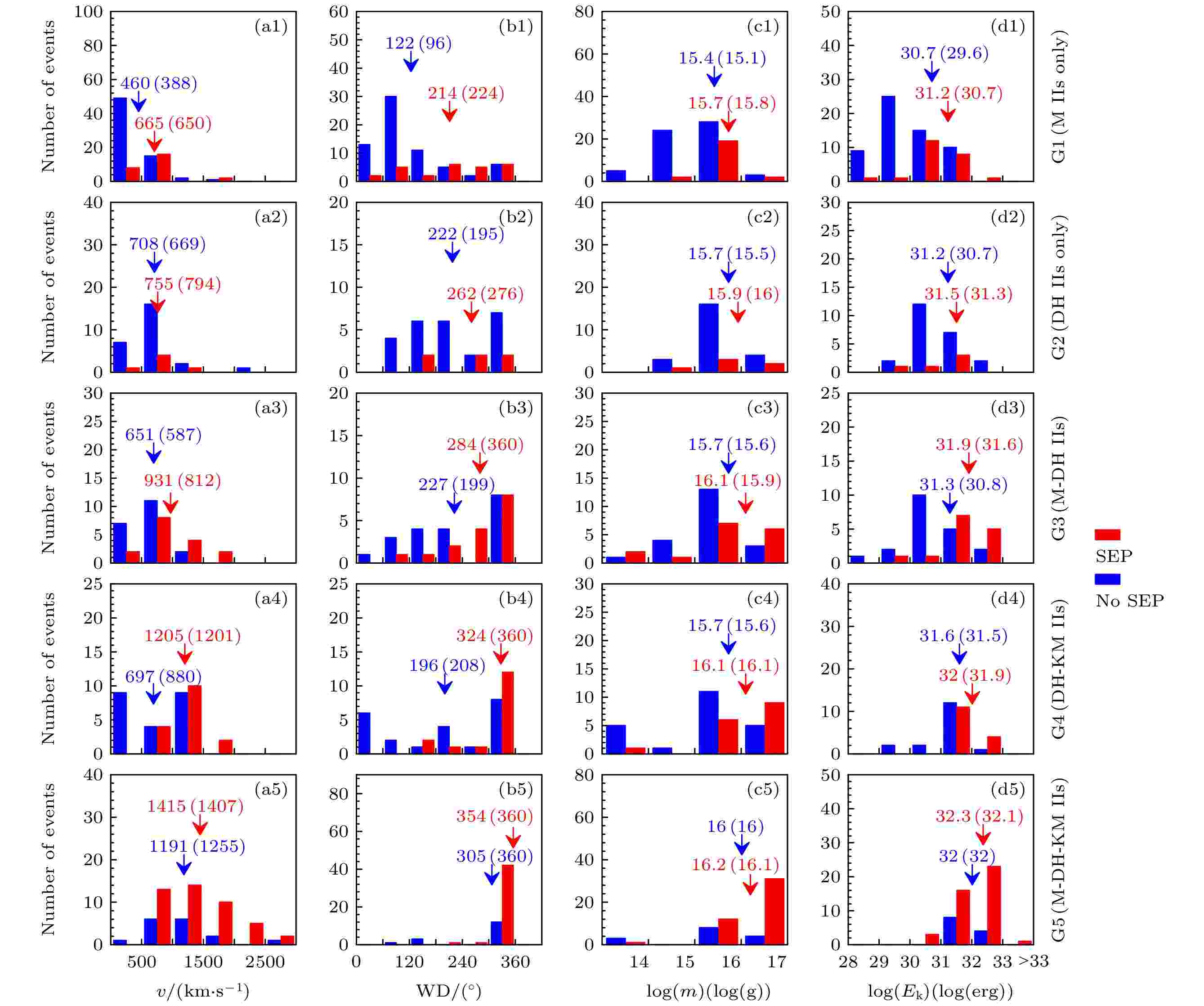
2021, 70 (9): 099601.
doi: 10.7498/aps.70.20201800
Abstract +
In this paper, we investigate 273 type II radio burst events detected by Wind, STEREO spacecraft from January 2010 to March 2018 during the 24th solar cycle. We classify all events as five groups or sub-types according to their starting and ending frequencies, and then analyze the observed characteristics of each group of type II radio bursts and the correlation between the occurrence of solar energetic particle (SEP) events and the associated coronal mass ejection (CME) or type II radio bursts. What we find is as follows. 1) In each group of type II radio burst events, the CME speed (v), width (WD), mass (m), and kinetic energy (Ek) associated with SEP events are generally greater than those with no SEP events, indicating that the generation of SEP events requires a fast and wide energetic CME eruption. 2) Compared with type II radio bursts starting from the DH band, type II radio bursts starting from the metric band have a higher proportion of large SEP events. Multi-band type II radio bursts are more likely to produce SEP events than single-band events, where M-DH-KM type II bursts have the highest proportion of SEP events (73%), and the DH IIs only have the lowest one (19%). 3) In each kind of type II radio bursts, the type IIs with SEP events usually have higher starting frequencies (lower shock forming heights), lower ending frequencies (higher ending heights) and longer durations than those with no SEP events; coronal shock waves that are easy to produce SEP events (especially large SEP events) generally begin to form at a lower height (such as < 3Rs, Rs: solar radius), and are sustained to a much larger height (such as > 30Rs). 4) There exists a strong negative correlation between the duration and the ending frequency of type II radio burst (cc = –0.93). The proportion of SEP events increases with the increase of the duration of type II radio burst, and decreases with the increase of the ending frequency, which largely depends on the CME speed and other properties. The results of this paper further show that the generation of SEP events is greatly related to the sub-types and characteristics of type II radio bursts. The higher the starting frequencies and the lower the ending frequencies of type II radio bursts, such as M-DH-KM type II bursts, of which the CME drives to forming shock waves at a very low height and propagates to a very large height, the longer the duration of the shock, the longer the time it takes to accelerate the particles, and the greater the probability of SEP events (especially large SEP events) is.








